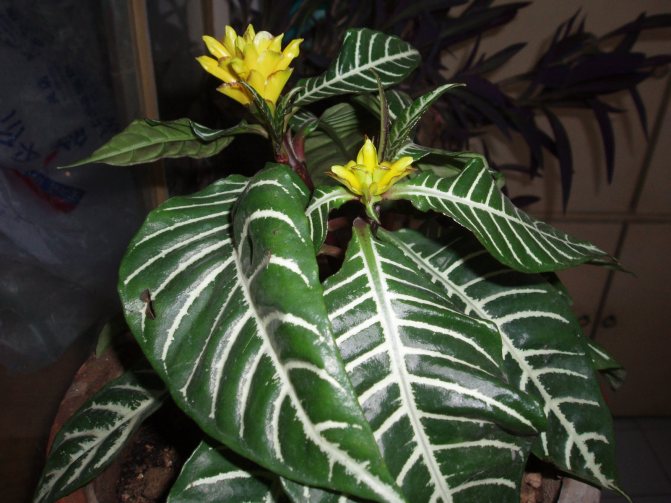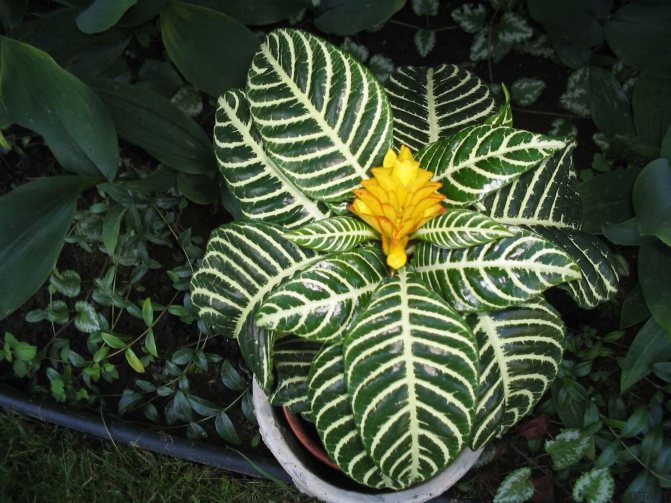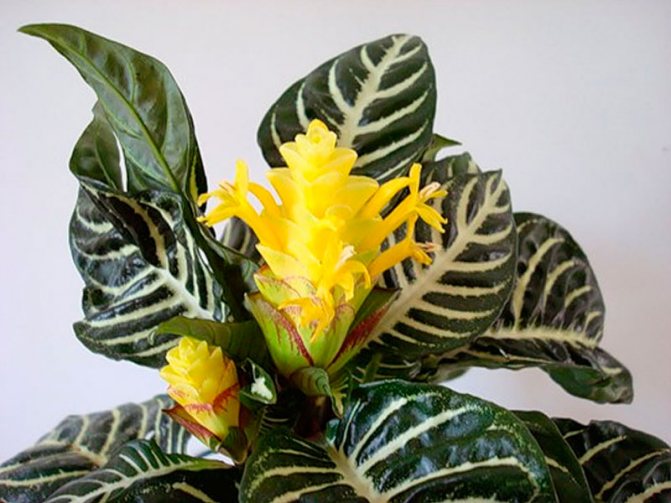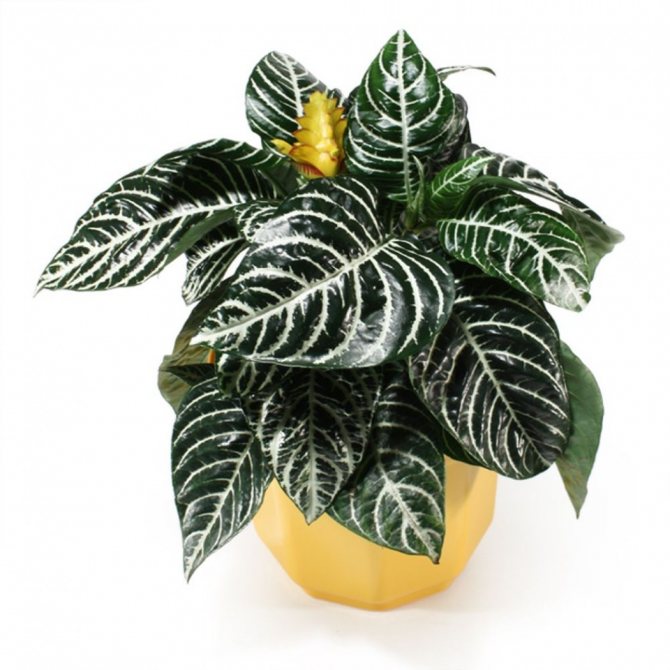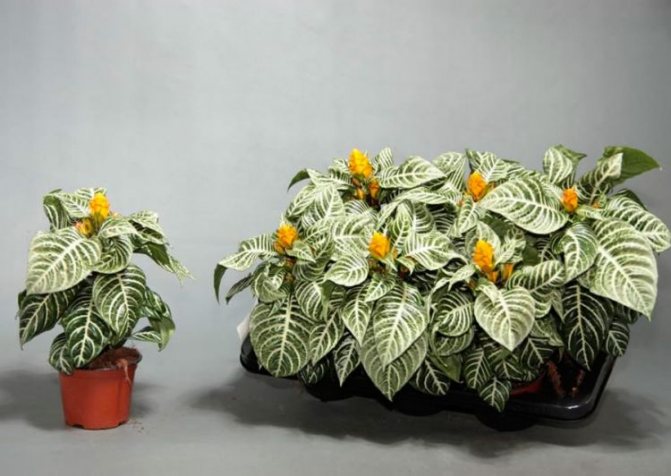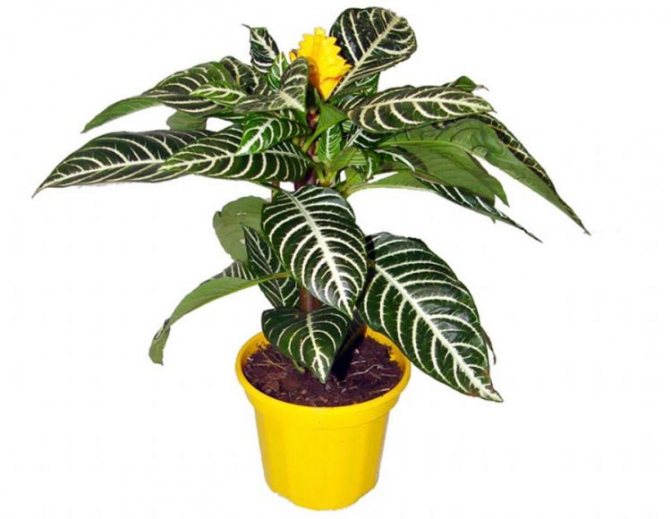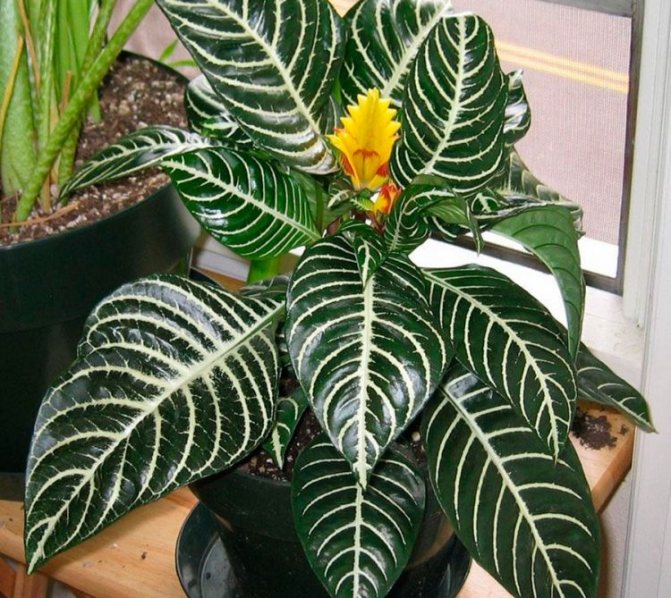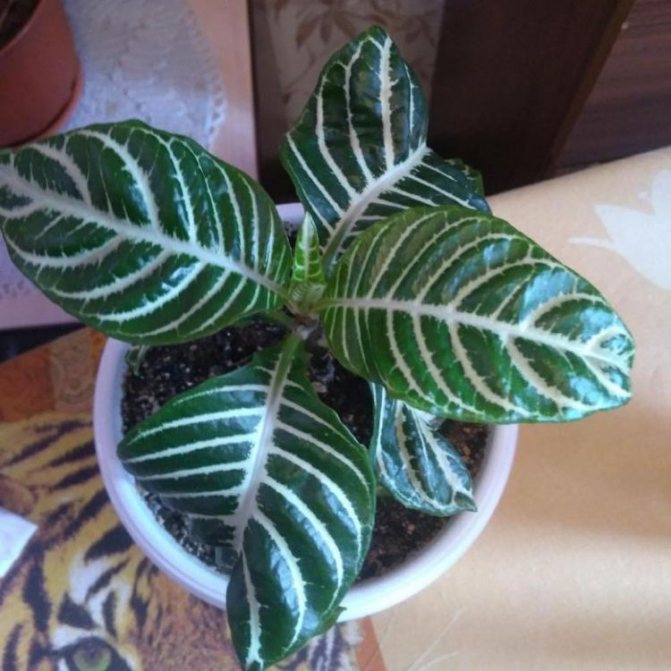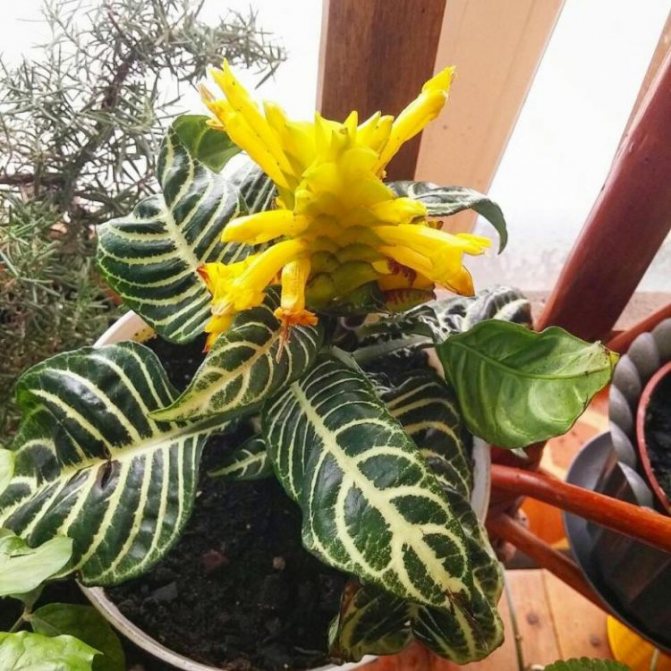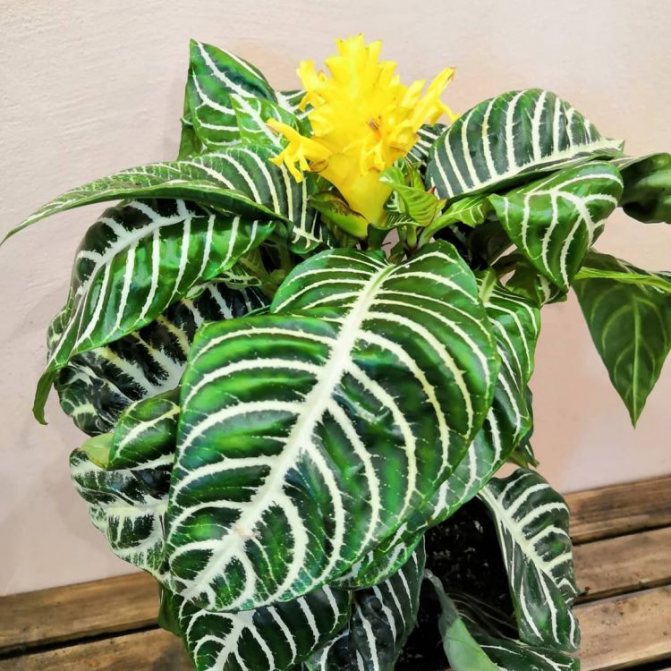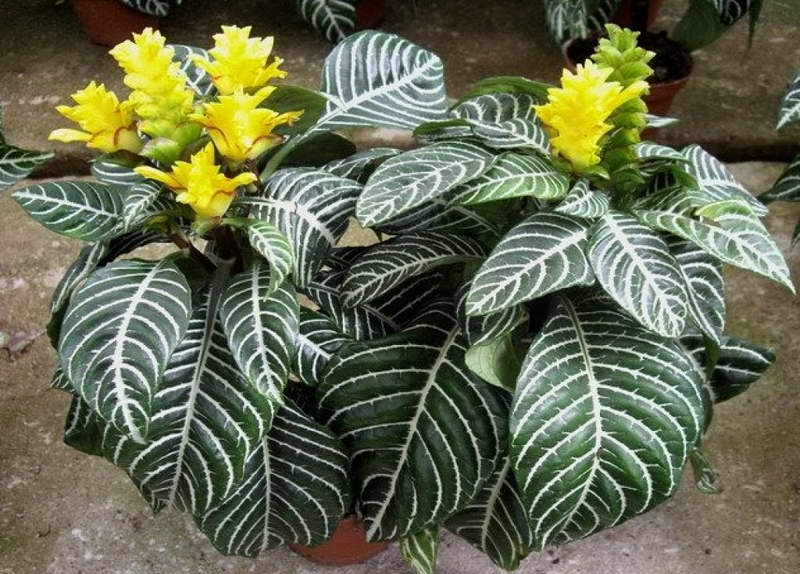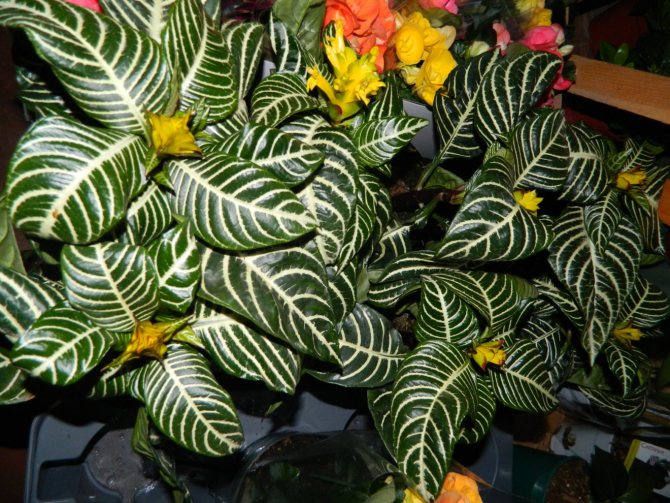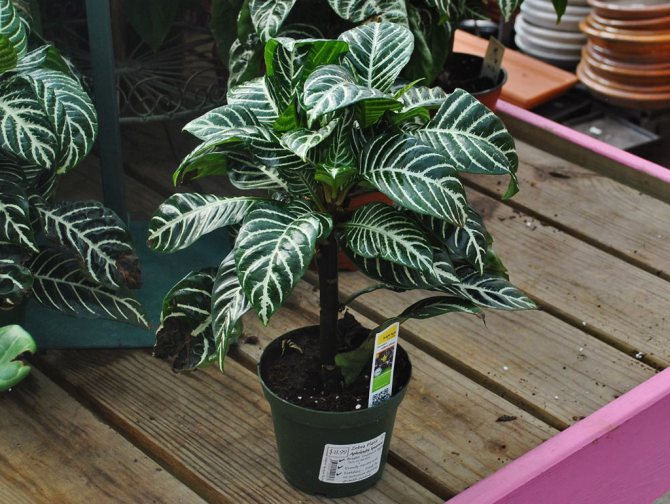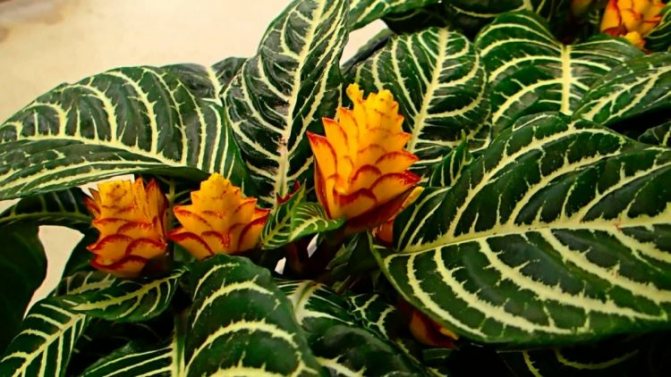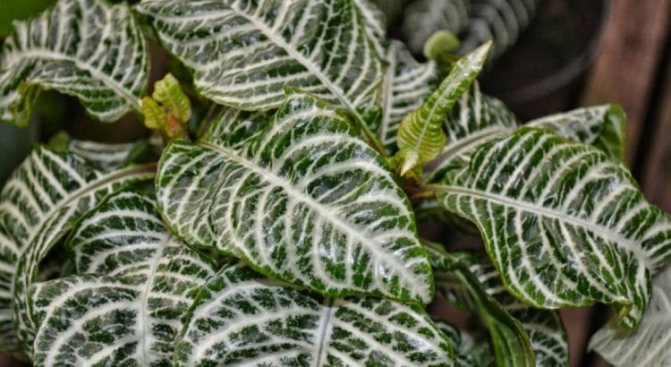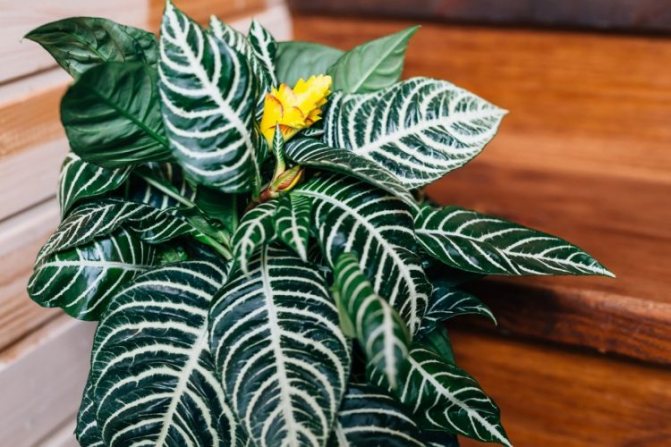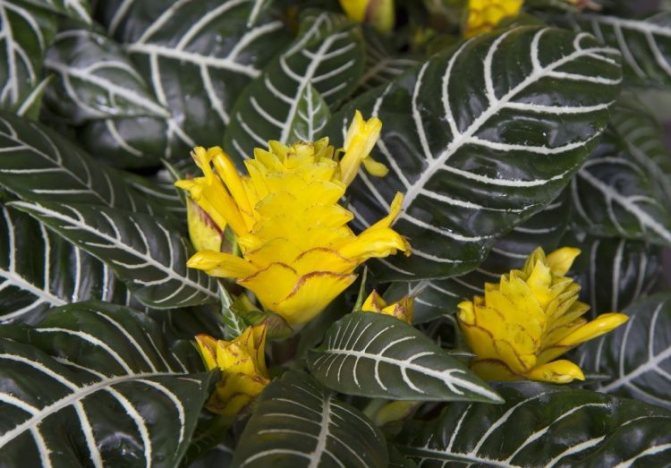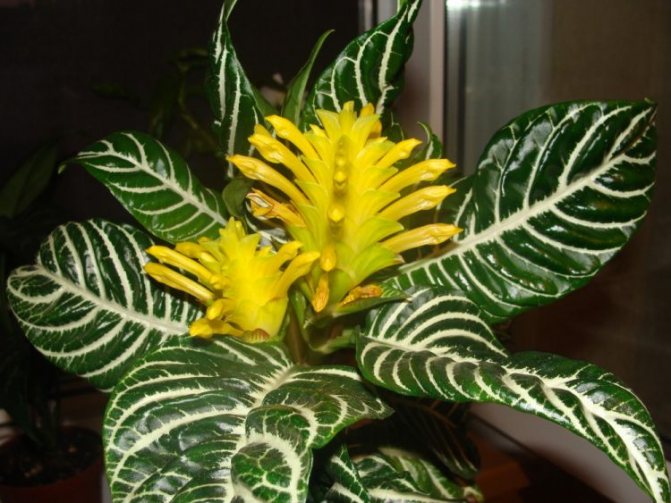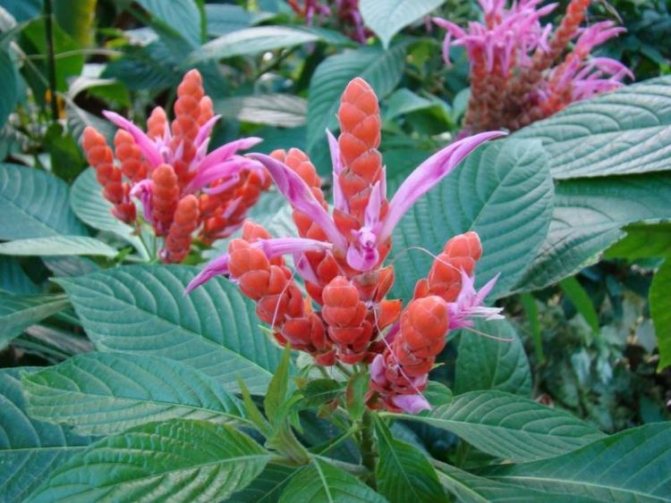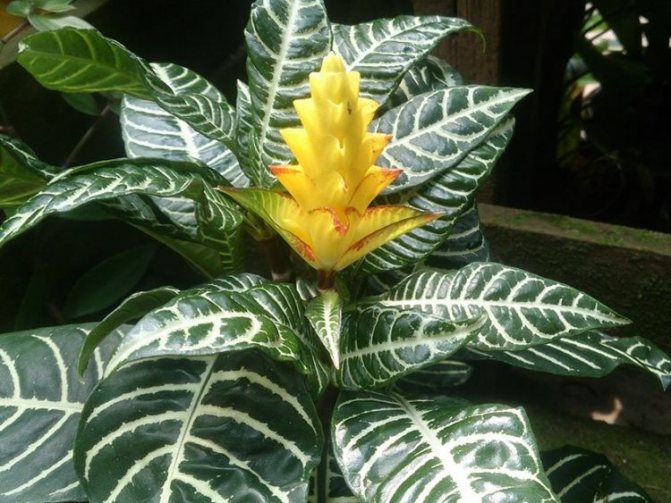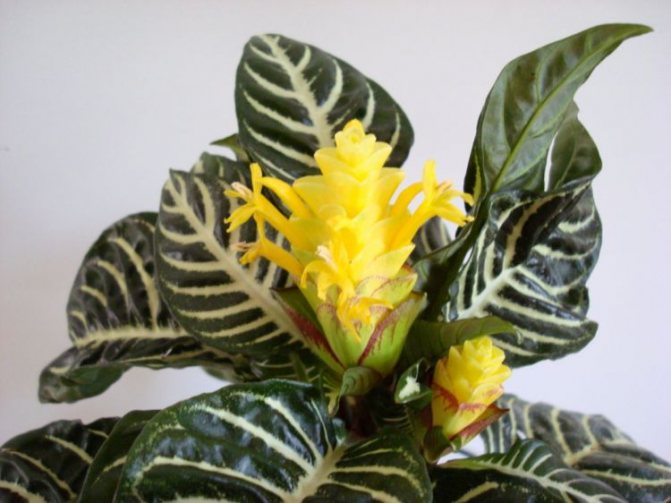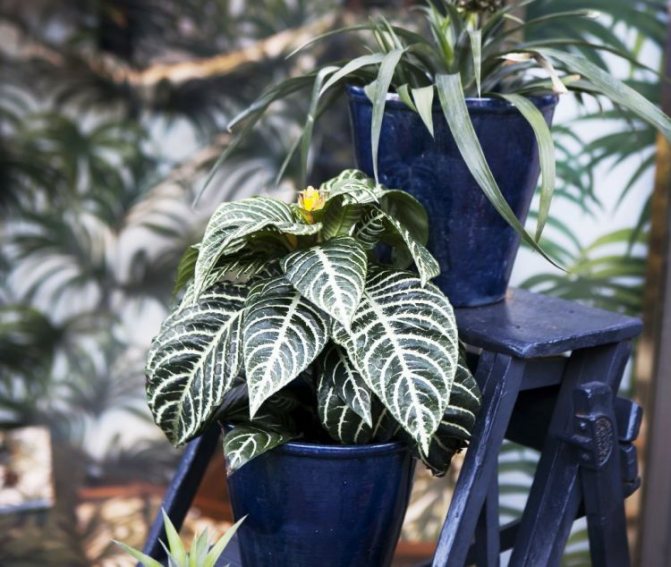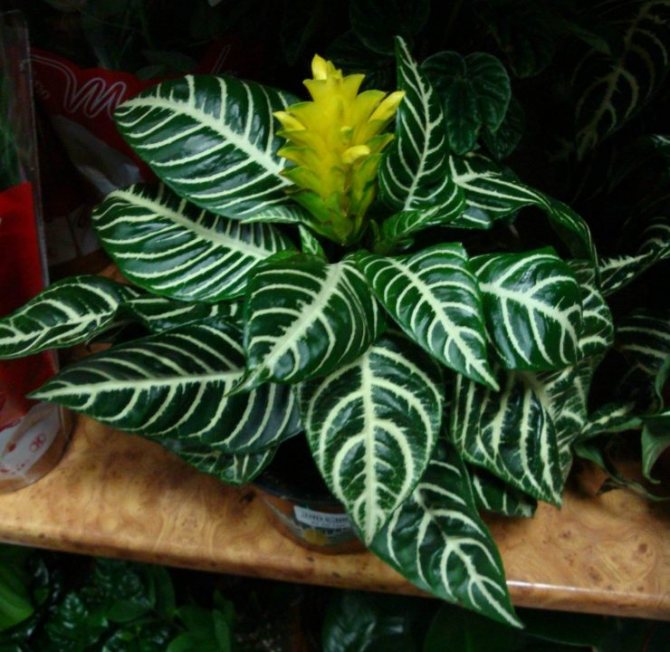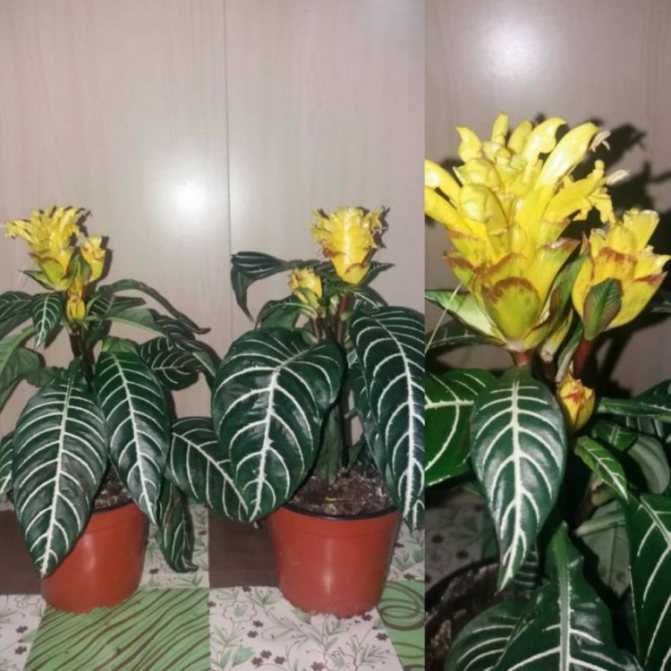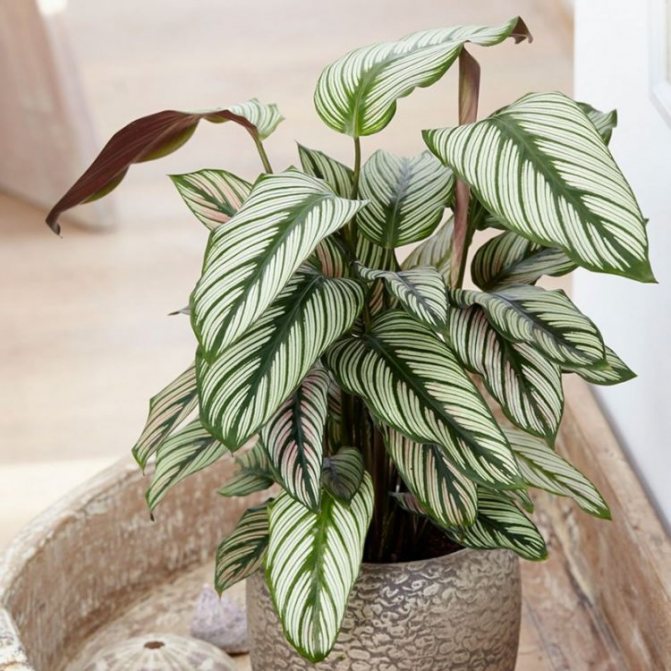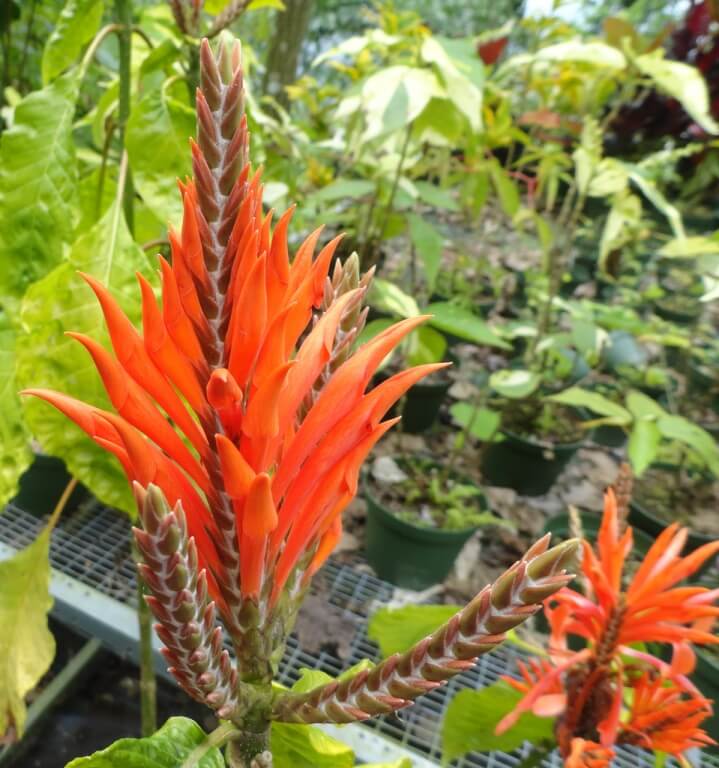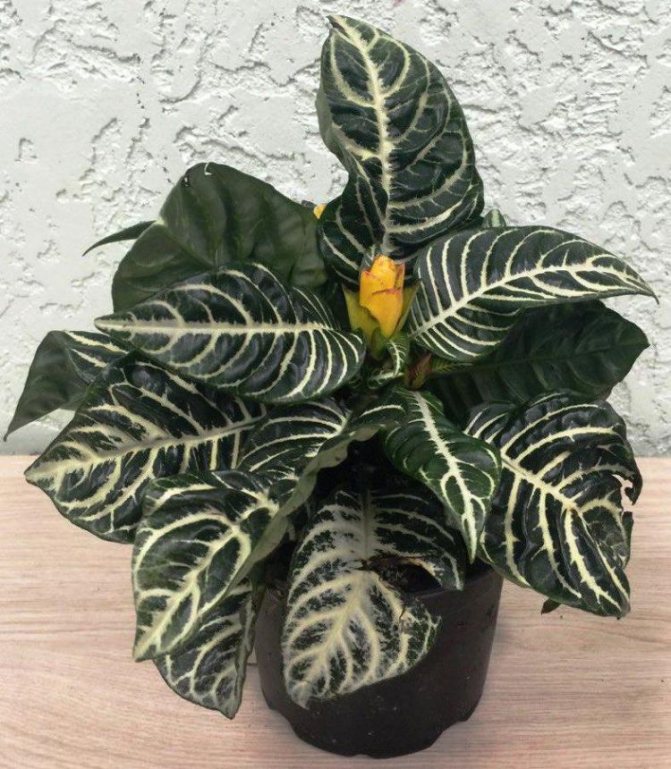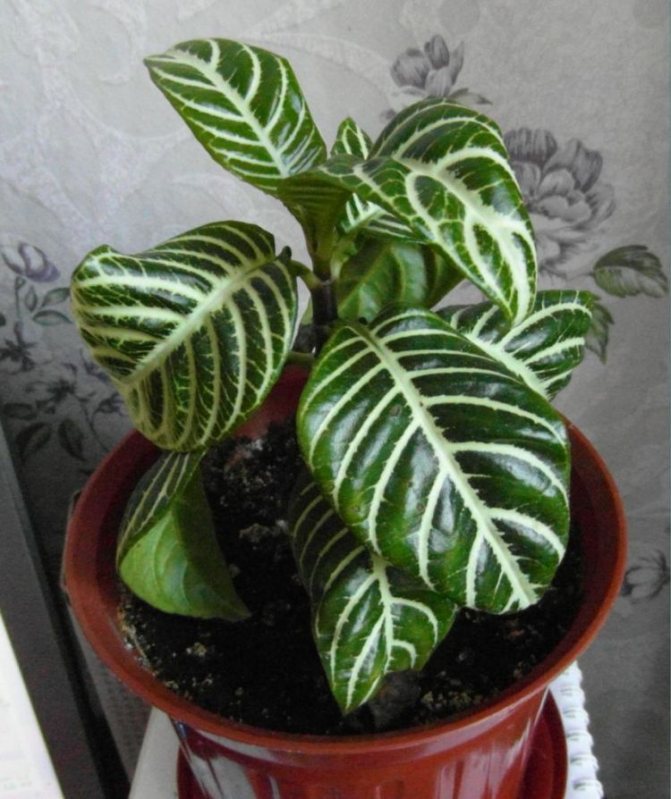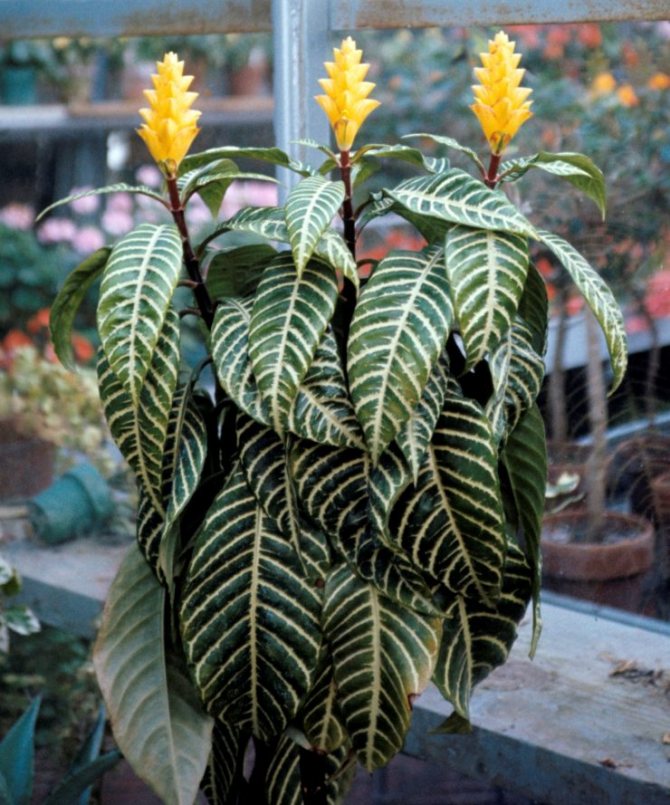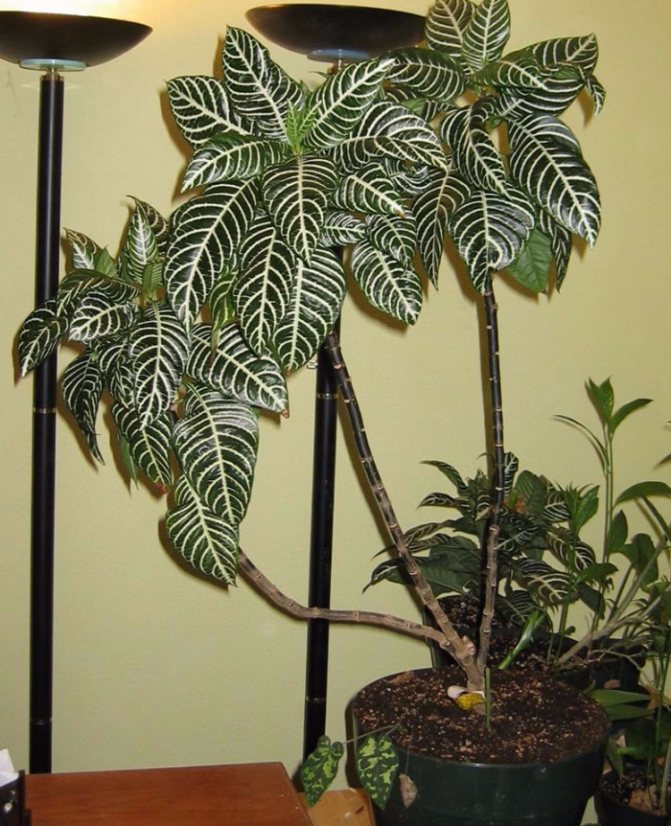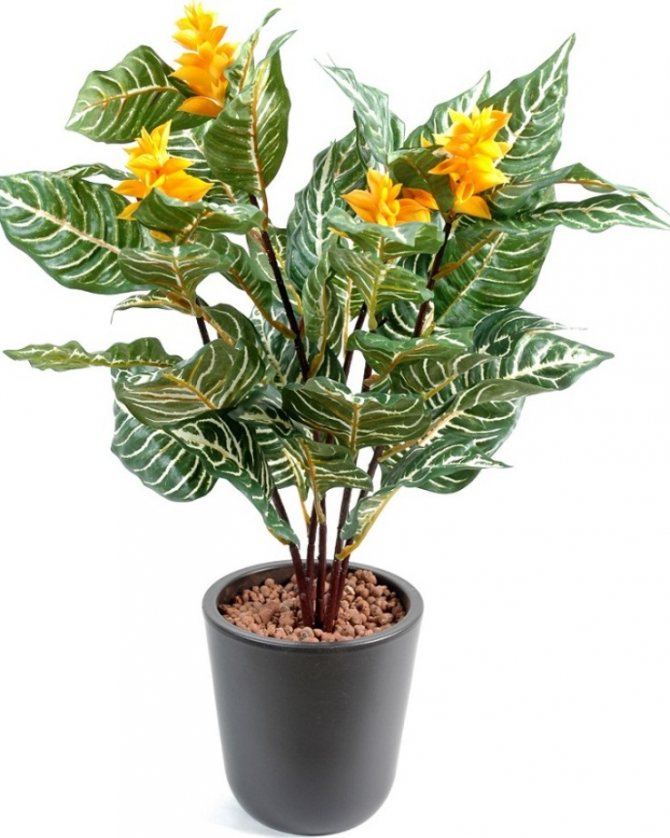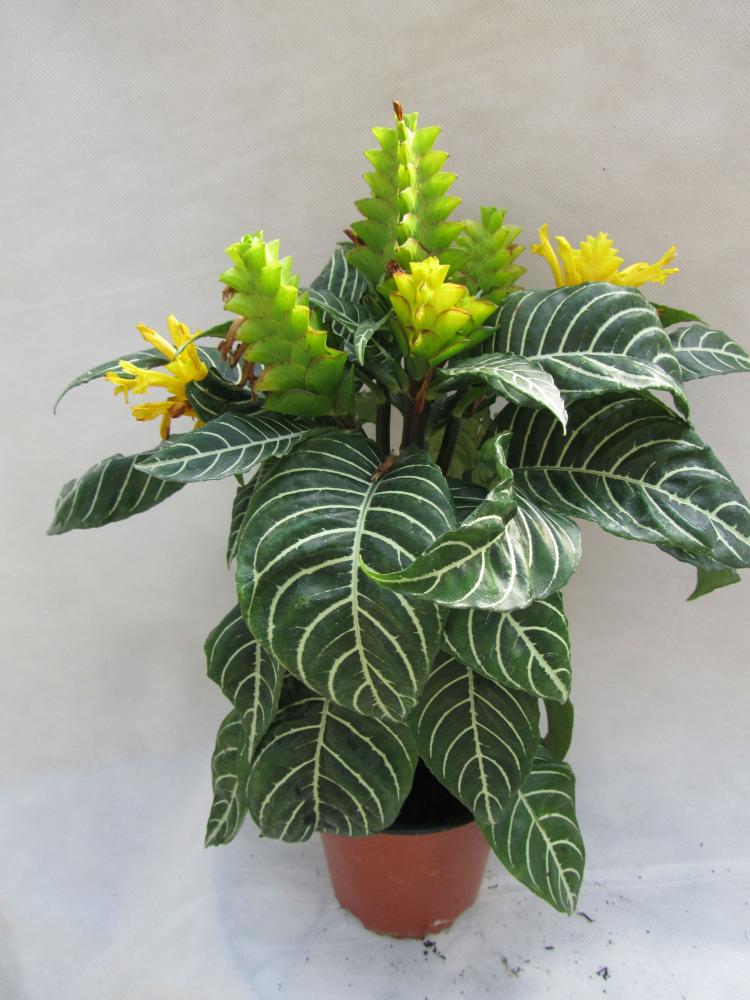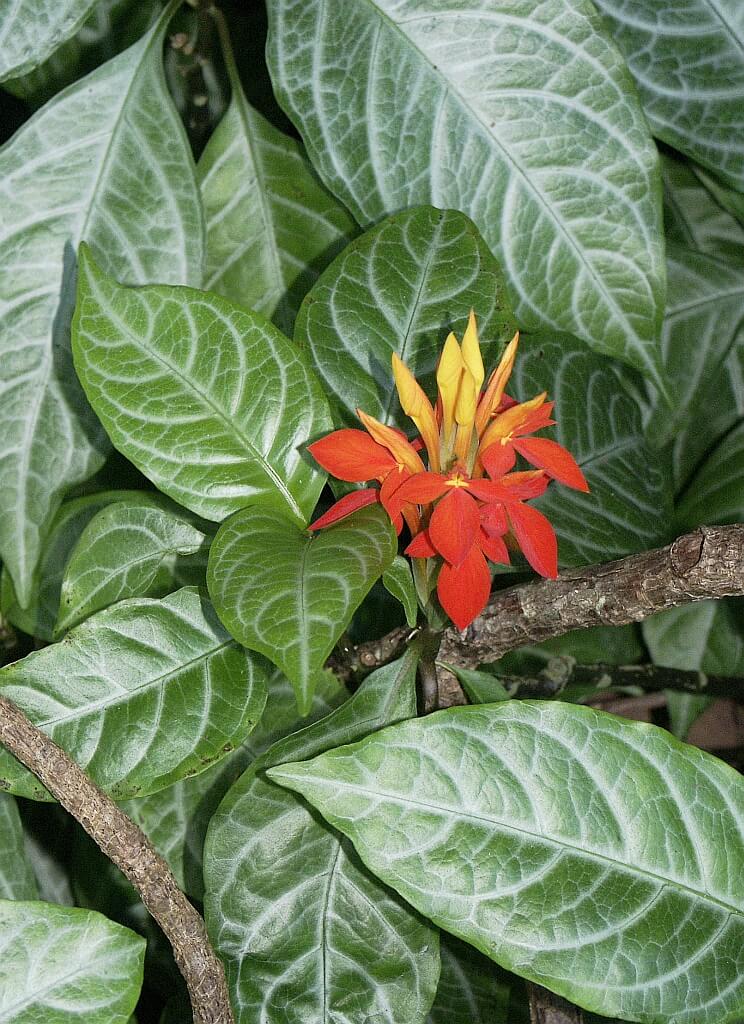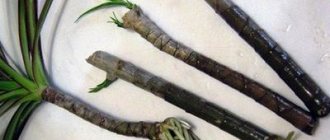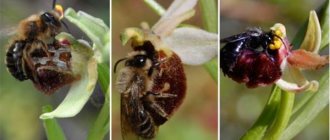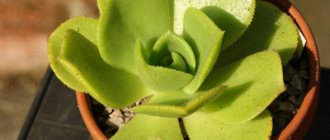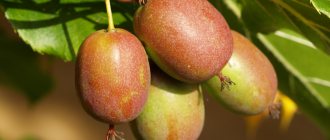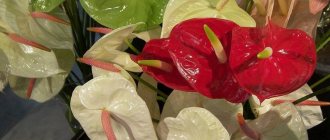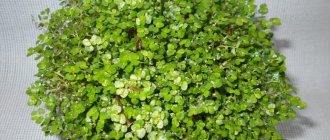The bulging aphelandra (Aphelandra squarrosa) belongs to the Acanthaceae family. Of the many species, the bulging Afelandra is the only one grown at home. Afelandru is classified as a plant with decorative leaves, the reason is a rather short, 3-week flowering period. Large, beautiful, dark green, shiny leaves, have an additional decoration in the form of a creamy white or almost white venation. The shape and contrast of the venation formed the basis of the traditional English name 'Zebra plant'. Spike-shaped inflorescence, appearing at the top of the shoot, consists of leaves transformed into yellow bracts. From the bracts grow yellow tubular flowers, odorless.
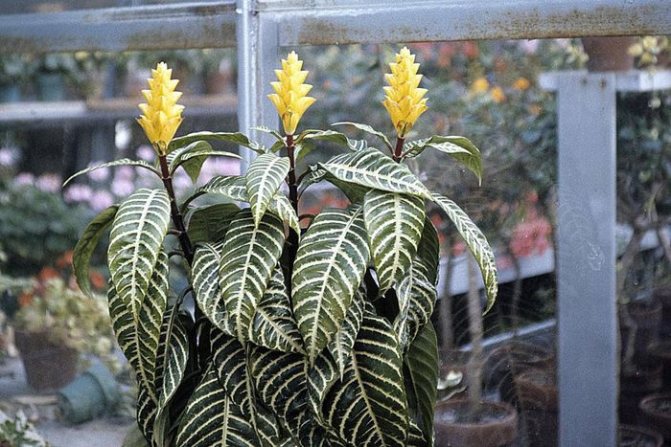
The fall of the leaves of the aphelandra is a natural process, it preserves the leaves only in the upper part of the shoot, the fall of the lower leaves is a natural tendency.
Description of aphelandra squarrosa
Squarrosa is distinguished by its high decorative qualities and deserves the efforts of a florist. In the Mexican rainforests, the fast-growing shrub reaches a height of one to two meters. In indoor floriculture, it does not grow above 70 centimeters. Among the many types of herbaceous shrubs, the most popular among flower growers are:
- Afelandra orange;
- Afelandra is protruding.
Breeders have bred several varieties of the latter species:
- Louise;
- Denmark;
- Leopoldia.
The bulging Afelandra is most often found in green collections. Stunted view with bare smooth stems of a red tint. The glossy surface of leathery leaves of deep green color is decorated with wide white veins. The length of opposite leaves reaches 30 centimeters. Flowering period: mid-July - early November. Bright yellow tubular flowers are collected in a tetrahedral spike. The height of a flowering inflorescence often reaches 20-30 centimeters. The fruit is a capsule with two seeds in each section.
Always decorative
Afelandra (Aphelandra) is a representative of the tropical flora, a hygrophilous and thermophilic flower of the acanthus family. It is grown as an ornamental-leaved and ornamental-flowering houseplant. This is a perennial shrub or shrub with large, contrastingly colored leaves, reaching a height of two meters in nature. Domestic aphelandras grow no more than 1–1.3 m, and most of them are shorter, especially if you buy a compact variety.
Afelandra juice is considered poisonous, so pruning and transplanting is carried out with gloves.
The leaf plate of the flower is shiny, can be corrugated and smooth. The color is variegated: on the green surface of the leaf there is an ornament of white or silver stripes along the middle and lateral veins.
The flowers of the aphelandra are small, but the bracts are very decorative: they are bright and collected in the form of a faceted spike or a pyramid 10–15 cm long. There are orange, yellow and red colors.
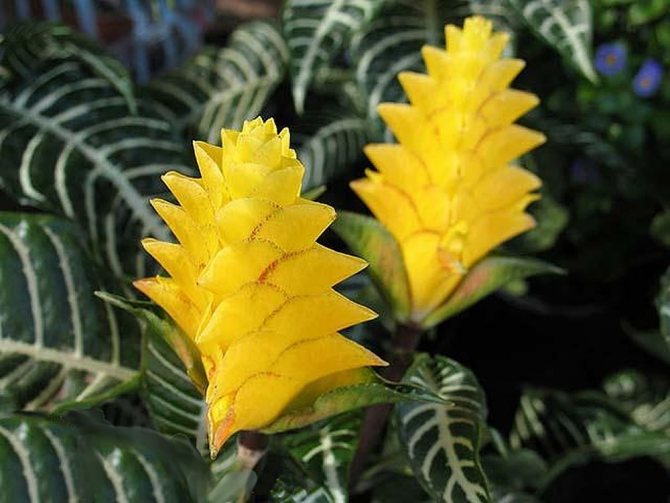

Afelandra bracts are more decorative than flowers
The native land of the flower is the South American and North American rainforests.
It is believed to be a very moody plant and requires a lot of effort to grow successfully.This is not entirely true: if you initially provide Afelandre with optimal conditions for it, it will grow and delight you with its flowering.
Afelandra home care
Knowing how to care for Afelandra, you can surprise colleagues and competitors-florists with a magnificent tropical specimen. Tropical and subtropical plants are not distinguished by high endurance, like cacti and succulents, so a novice florist should approach the study of agricultural technology with the utmost responsibility.
The main rules for the cultivation of scuarrosa are aimed at recreating the natural growing conditions.
Caring for afelandra at home consists in maintaining the irrigation and lighting regime, constant temperature and humidity. Also, the optimal composition of the planting substrate and the timely introduction of dressings are of no small importance.
Brief "biography" of scuarrosa
It was not for nothing that we used the name “scuarrosa” in the title, because this is how Afelandra is called in her homeland, Mexico. This representative of the flora belongs to the Acanthus family. Of all the existing species of aphelander scuarros, the protruding is the only one that is cultivated in our country at such a high level.
- Leaves.They are oval-elliptical, large, reaching 0.3 meters in length. The sheet plate has a glossy structure. The main color of the leaves is a deep green, dark shade. Each leaf has clearly visible, contrasting white-silver streaks. If you turn the leaf over, you will see that the color of its back side is far from as intense as the color of the front.
- Flowers. Double-lipped, tubular. Collected in inflorescences that resemble spikelets in appearance. The length of the inflorescences can reach 0.3 meters. The bract of afelandra is always variegated orange and very bright. But the color of the flowers themselves is yellow.
The flowering of afelandra is a rather lengthy process: under favorable conditions, the flowers on the exotic bloom in late spring and wither towards the end of autumn.
In order for the plant to always have a decorative look, it is necessary to remove wilted inflorescences from the bush.
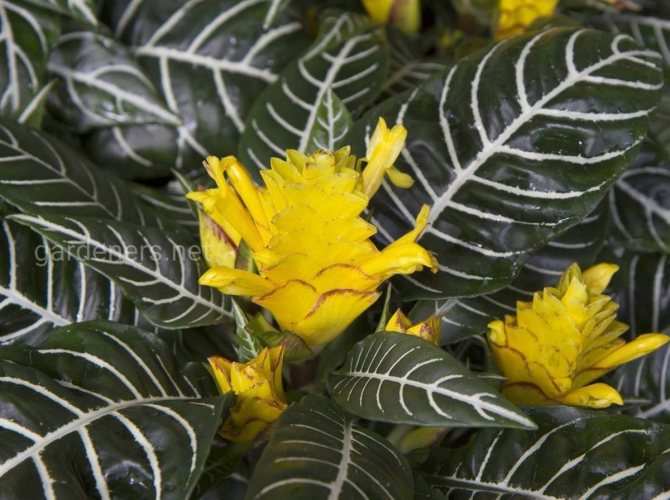

Afelandra lighting mode
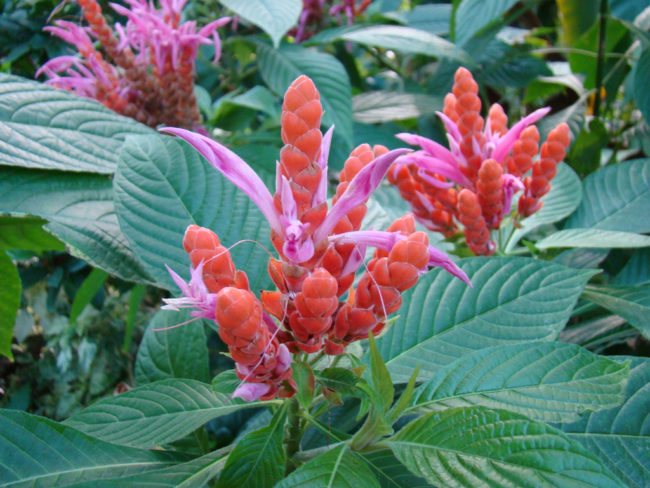

Shrubs of tropical and subtropical forests are hidden from the scorching sun by the crown of tall trees. When choosing a permanent place for squarrosa in your home or office, you should stick to the golden mean. Avoid placing the plant on a hot south window. The dimly lit northern room will not work for her either.
The optimal solution would be an east or west orientation of the lighting, where the aphelandra will be inaccessible to the merciless midday rays of the sun. It is necessary to closely monitor the aphelandra in the sultry summer and organize a diffused shade in time to avoid sunburn of the decorative leaves.
In the autumn-winter period, when the nights are getting longer, the ornamental bush needs an artificial extension of daylight hours. The duration of lighting should be at least eight to nine hours. Experienced growers use fluorescent lamps, which are placed 60-70 centimeters above the top of the squarrosa.
Video: the story of Afelandre
Despite the fact that Afelandra is very thermophilic and requires constant maintenance of a high level of soil and air humidity, it is quite possible to cope with a capricious beauty. Buy a compact variety, put the plant in a place with bright diffused light without drafts, do not forget to water and feed, and in spring, transfer to a slightly larger pot and pinch the tips of the upper shoots - and you can enjoy the spectacular greenery and bright flowering of this tropical flower all year round.
Temperature and humidity
Tropical and subtropical crops grow in a stable microclimate, not subject to sudden changes in temperature and humidity.
In the same way, Afelandra reacts extremely negatively to hypothermia, a significant difference in daytime and nighttime temperatures. Squarrosa develops well only when the temperature and humidity are stable.
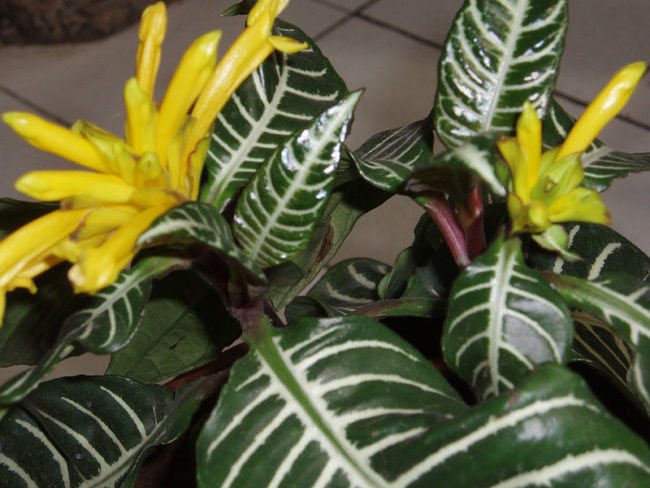

During the period of active vegetation and rapid growth of aphelandra, it is necessary to maintain + 24 + 26 ° C heat. The humidity level must be at least 60%. During airing, it is necessary to exclude destructive drafts that cause leaf fall. The shrub responds favorably to summer vacations on a sheltered terrace or enclosed balcony.
The tropical species does not have a pronounced dormant period. From November to March or April, the plant grows less actively. It is allowed to take the flowerpot out to a cooler room to stimulate future flowering. Afelandra is resting at a temperature of + 18 + 20 ° C. Air humidity remains at the same level.
The maintenance of high air humidity is facilitated by the irrigation of air from the spray gun, the placement of containers with water next to the flowerpot, and the use of a system of two pallets. Small pebbles with water, placed in a tray, have proven themselves well. Florists add some water so that the level does not reach the drainage holes.
Varieties for home cultivation
In nature, there are more than 170 varietal variations. Only two species have adapted for keeping in room conditions - protruding aphelandra and orange aphelandra, however, the second species on sale is extremely difficult to find.
The bulging aphelandra (Aphelandra squarrosa) can grow in a pot up to 130 cm, and this flower stretches quickly, so most growers prefer to buy its more compact hybrids: Louise, Brockfield, Denmark.
Orange aphelandra (Aphelandra aurantiaca) is a short shrub with a fleshy stem. As the plant matures, the trunk gradually lignifies. This type of aphelandra has large silvery-green leaves. The flowers are tetrahedral, bright orange. Flowering lasts about 7 days. Bracts and flowers in all varieties of bulging aphelandra are bright yellow... Under comfortable conditions, it blooms from June to November, on average, flowering lasts 6 weeks.
Photo gallery: varieties of afelandra for indoor keeping
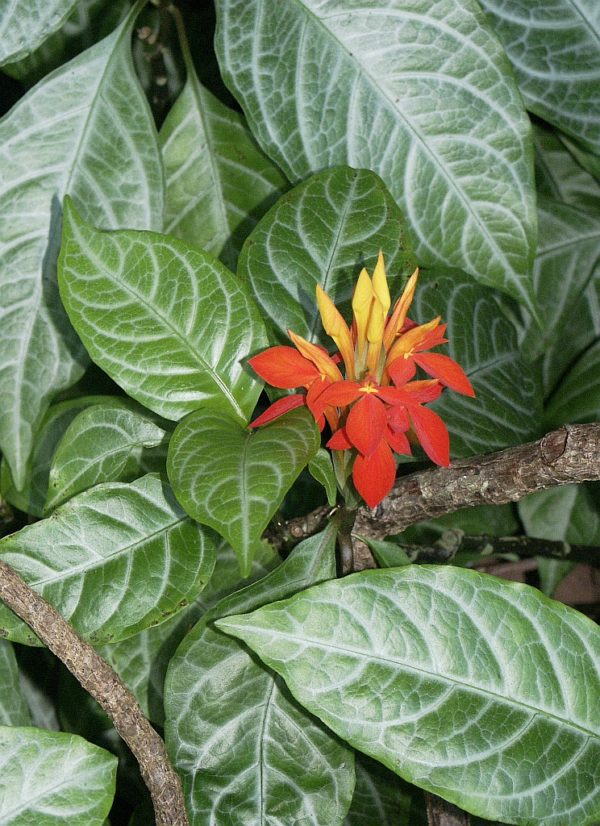

Afelandra orange leaves are silvery-green, without contrasting veins
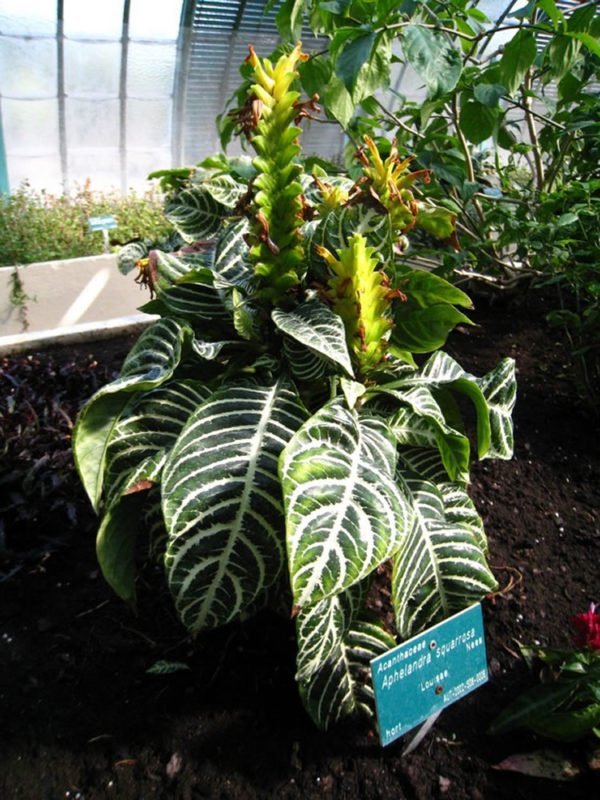

Louise is a medium-sized home shrub
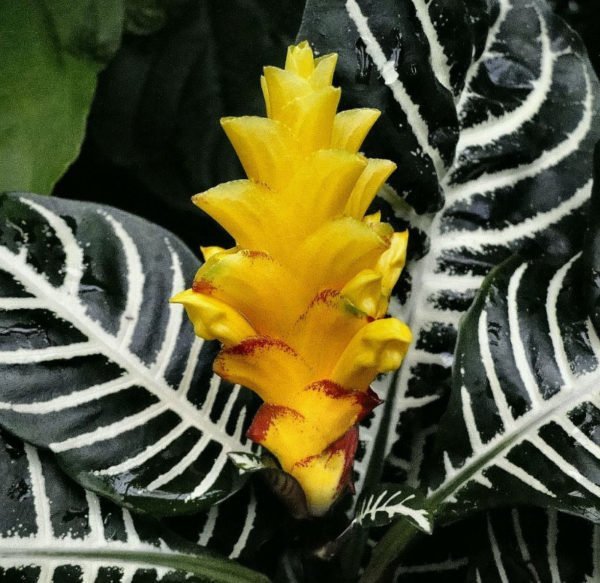

If you are attracted to patterned leaves, choose Fitz Prinsler
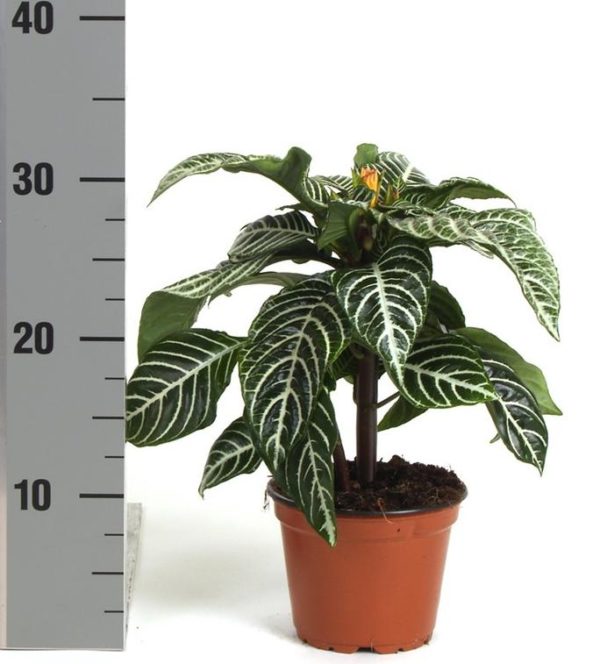

Brockfield and Denmark are considered the most compact varieties.
Video: compact afelandra
How to properly water Afelandra
An ornamental shrub reacts extremely negatively to both overflow and drying out of the substrate.
Hard tap water from the city water supply is categorically contraindicated for use in the care of squarrosa. Preference is given to soft rain or melt water.
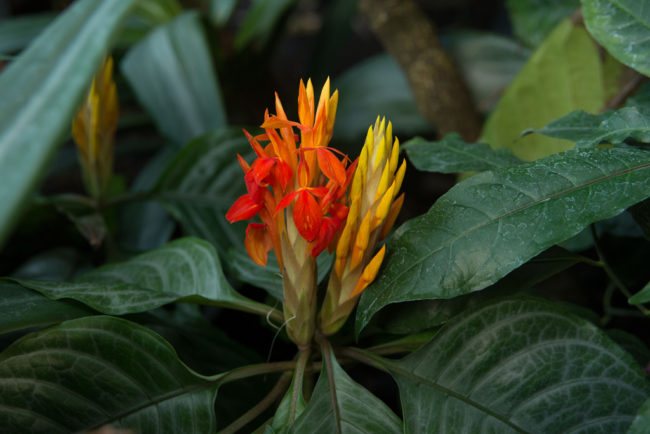

Otherwise, the water is pretreated. Most modern household filters remove chlorine and soften the water. In the absence of such, the water is defended in an open container for at least three days. Then it is boiled for five minutes so that the salts have time to precipitate. Water the aphelandra with lukewarm water using the overhead watering method.
Care should be taken to prevent water droplets from falling on large leaves. Subsequently, whitish spots appear in this place, which gives the specimen an unpresentable appearance. Excess water must be drained from the pan, excluding waterlogging of the soil. In summer, afelandru is watered every three to four days. In winter, watering is reduced to one or two per week.
Solution of problems
Problems with afelandra usually begin with improper care. They can manifest themselves in different ways, but if you do not respond to the sos signals, the flower will die very quickly.
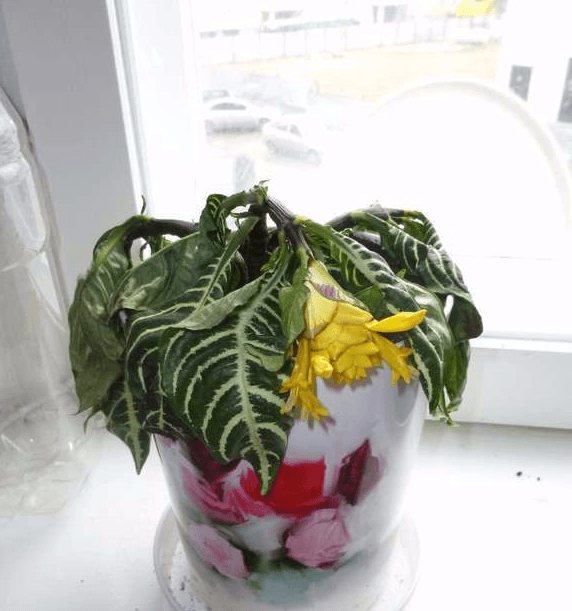

This Afelandra was most likely kept in a cold draft.
So, the main thing is to diagnose the cause of the deterioration in time and correct the shortcomings.
Care errors and their elimination - table
| Problem | Cause | Elimination |
| Falling leaves | Insufficient watering | Adjust watering mode |
| Draft or low room temperature | Move to a warm place without drafts | |
| Plenty of bright sunlight | Cover or remove the plant from direct sunlight | |
| Lack of nutrients in the soil | Adjust the feeding mode | |
| Dry air | Spray the leaves every day, place the pot on a pallet with damp drainage | |
| Plant wilting | Cold draft | Rearrange the flower to a different location |
| Brown leaf edge | Mold damage | Remove the infected leaves, treat the plant with a fungicide according to the instructions |
| Insufficient moisture | Spray the leaves every day, place the pot on a pallet with wet sawdust | |
| Brown spots | Excessive amounts of bright sun | Ventilate the room regularly or change location |
| Lack of fresh air | Shade or rearrange the plant | |
| Shrinking leaves | Lack of minerals | Adjust the feeding mode |
| Pot too tight | Transplant into a larger pot |
Thanks to its poisonous juice, this flower rarely gets sick, but waterlogging is destructive for it: fungal diseases - rot can develop. In addition, a plant weakened by improper care loses its immunity and is easily affected by pests.
Diseases and pests of Afelandra - table
| Source of defeat | Signs of the disease | Prophylaxis | Treatment |
| Shield | Brown plaques and sticky drops on the leaf plate | Regular inspection and wiping of leaves with a damp cloth | One-time or weekly (in case of severe infection) treatment with chemicals Fitoverm or Actellik |
| Falling leaves | |||
| Mealybug | Whitish bloom on the leaves in the form of cotton wool | Wiping with soapy water followed by insecticide treatment | |
| Aphid | Deformed tips of the sheet plate | Treatment with Akarin, Iskra Bio preparations or infusions of plants with a pungent odor, such as wormwood | |
| Dying leaves | |||
| Insect colonies on leaves | |||
| Root rot | Roots darkened and softened |
| Surgical. Cut off the affected parts of the root system (if all the roots are affected, the plant can no longer be saved), rinse the remaining roots, sprinkle the cuts with crushed coal and after a couple of hours transplant the flower into a new disinfected soil with good drainage. |
| Leaves gradually turn yellow and wither |
Photo gallery: Acanthus lesions
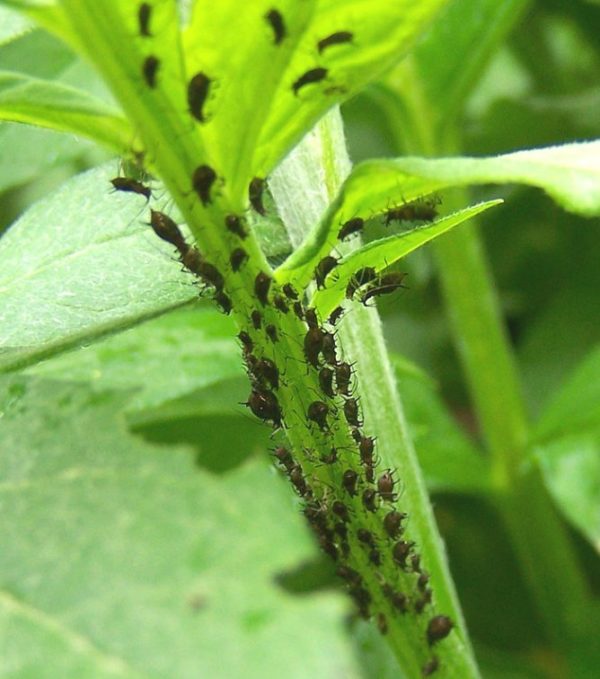

When aphids are damaged on the plant, insect colonies are clearly visible
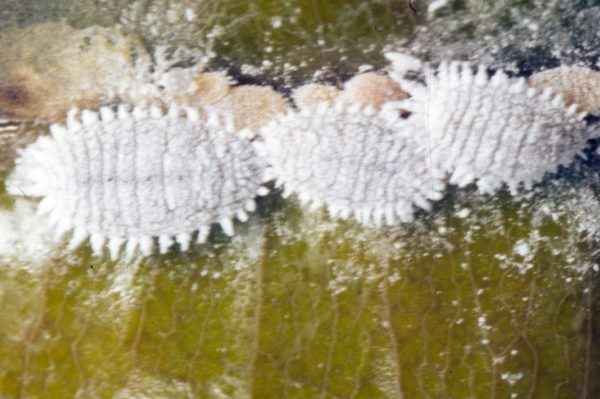

Mealybug looks like a white cottony bloom
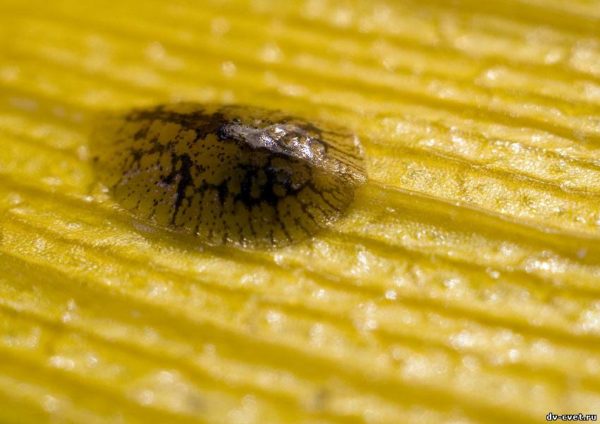

When damaged by a scabbard, brown sticky spots appear on the plant.
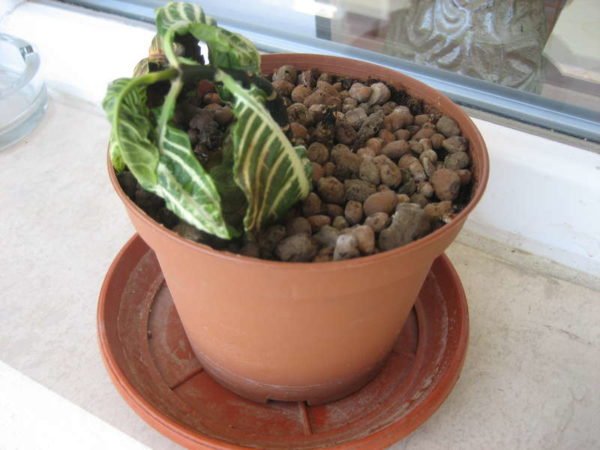

The rotted plant stops growing and gradually withers
What and when to feed Afelandra
This indoor species belongs to the fast-growing ornamental shrubs. The aphelandra root system assimilates the nutrient substrate very quickly and depletes it. The plant quickly falls into decay without the regular introduction of mandatory fertilizing.
Afelandra responds well to both organic and mineral fertilizers. The first feeding begins on the eve of the awakening phase in mid-March or early April. it is recommended to use ready-made complexes of mineral fertilizers for flowering indoor crops.
Aphelendra is fed at least and no more than twice a month, every two weeks.
The concentrate is diluted with water in the proportion recommended on the package. It should be recalled that fertilizers are applied under a pre-watered houseplant in order to protect the root system from chemical burns.
Reviews about the cultivation of Afelandra
In the spring I bought Afelandra, threw leaves all summer and eventually bent over.Although I like her, but I will not start any more. A very moody plant.
raduzhnaya
I had Afelandra before, and I don't want to mess with her anymore. Even with high humidity, everything is still wrong for her. Capricious, that's for sure. And she also throws off the lower leaves all the time, and this is a natural process for her, so she needs to be updated periodically. Well, it blooms normally, rests in the winter.
cheremisova galina
The yellow flower in combination with green juicy leaves looks great, just in order to dilute the dull room atmosphere, add vibrant and vibrant flowers.
Adolf
I thought that only my Afelandra was wasting away, but it turns out that this is her “birth disease”.
Alyonka
A little about the transplant of Afelandra
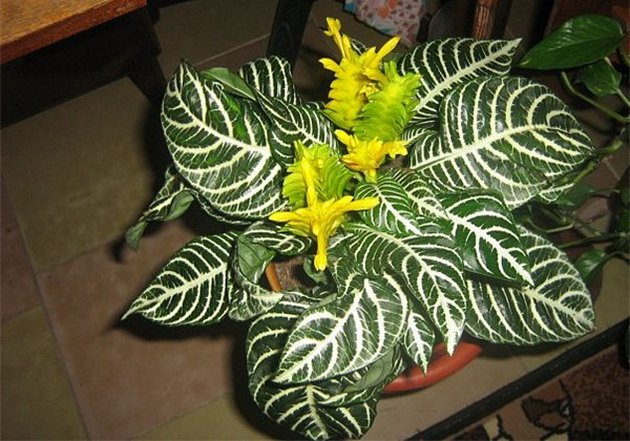

Young specimens quickly deplete the substrate and need to be transplanted annually. Until the age of three, the aphelandra is transplanted every spring before the onset of the rapid growth phase. The shrub has no special requirements for the material of the flowerpot. However, clay pots should be preferred as they have the best thermal insulation properties.
From the age of three, squarrosa is transplanted every two to three years. Few of the florists grows specimens older than five years, since younger plants are more willing to bloom, have a more attractive compact bush. From ready-made earthen mixtures, soil is suitable for flowering tropical crops such as azaleas. Experienced growers prefer to harvest the land for the green collection on their own.
The soil for aphelandra should have high aeration, water permeability, a slightly acidic reaction and a rich supply of micronutrients. Based on these requirements, the optimal composition is prepared by mixing three parts of sod or leafy soil with one part of sand and peat taken. Large pebbles, broken shards, pieces of polystyrene are used as a drainage mixture. It is not recommended to use broken brick or expanded clay, as they accumulate moisture, which can lead to decay of the roots.
Reproduction
Afelandra can be propagated in two ways: by seeds and cuttings. The second option is more preferable, since after fruiting, the mother plant often dies.
Seeds
Well-ripened seeds are harvested and immediately sown into the substrate. A mixture of sand and leafy earth (1: 4) is used as a soil. For germination, create greenhouse conditions and a temperature of at least 25 degrees. The greenhouse must be ventilated every day for 20 minutes. The grown seedlings are dived into small pots.
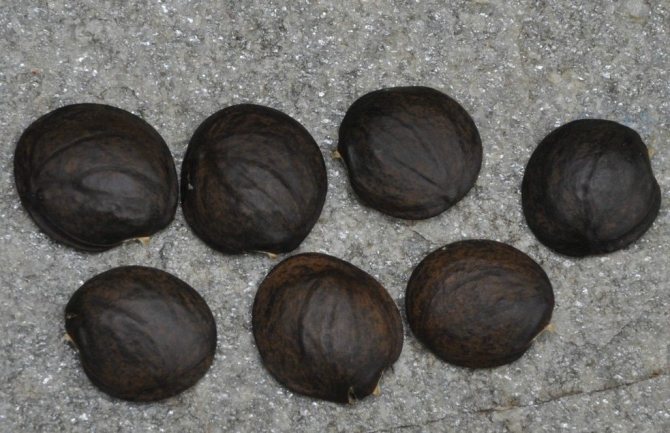

Afelandra seeds about 5 mm in diameter
Cuttings
Vegetative propagation is a much more reliable and simple method. Cuttings are made from March to May (less often in winter or summer). For this:
- Cut off annual shoots up to 15 centimeters long. There must be at least two leaves on them.
- Cuttings are treated with drugs that stimulate root formation: Athlete, Baikal EM-1, Kornevin and others.
- Rooting is carried out in a moist peat or sandy substrate. Create a greenhouse environment by covering the cuttings pot with foil or glass.
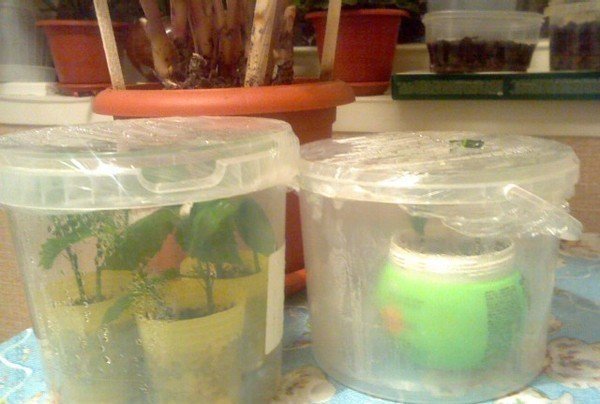

One way to create a greenhouse is to place the jars of plants in a transparent plastic container.
- The container with the handle is placed in conditions with diffused light and a temperature in the range of 22-24 ° C.
- The greenhouse is ventilated for 10 minutes a day.
- Rooting takes place within 1–2 months. After that, they are transplanted into small pots and begin to look after, as for adult plants.
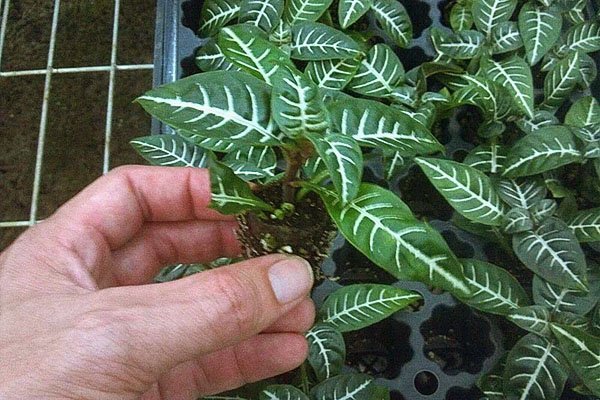

Afelandra cuttings take root up to two months
Formation of the crown of afelandra
A fast growing shrub needs regular pruning. Aphelendra, not undergoing annual formative pruning, sheds the lower leaves. The exposed fleshy trunk negatively affects the decorative qualities of the specimen.
The squarroso should undergo a radical pruning every spring in February-March.
The crown of young bushes is formed by pinching.
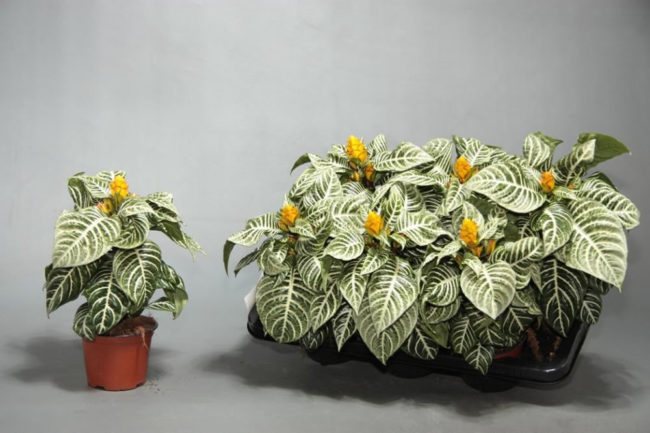

The apical points of growth on all shoots are pinched off by hand, forcing the plant to release side shoots. Thus, a compact spherical crown is formed. Well-groomed Afelandra looks especially impressive during the flowering period. Three to five-year-old bushes are pruned on a large scale. Usually, growers shorten all the shoots, leaving only 30 cm areas. Rejuvenating pruning returns an attractive compact appearance to an adult specimen and exposes it to a lot of stress.
It is recommended to carry out a number of special anti-stress measures for the successful adaptation of squarrosa.
Experienced florists arrange a mini-greenhouse for the plant. Typically, for this purpose, the specimen is covered with a glass jar, cut off with a plastic bottle or plastic bag. The mini-greenhouse is ventilated daily to prevent rotting of the sections. Also, numerous sections are disinfected with crushed activated charcoal or charcoal. It is recommended to add the anti-stress drug "Epin" to the irrigation water.
Photo
Below you can see what the plant looks like. It is bulging:
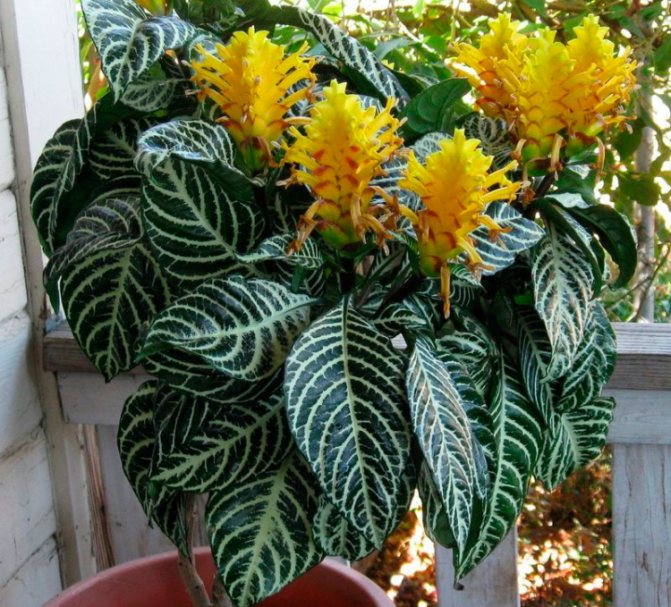

This is what a tetrahedral looks like:
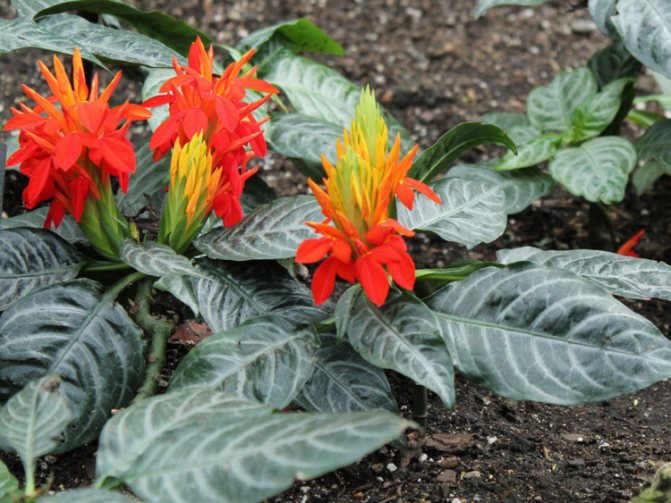

And in these photos - gold (orange):
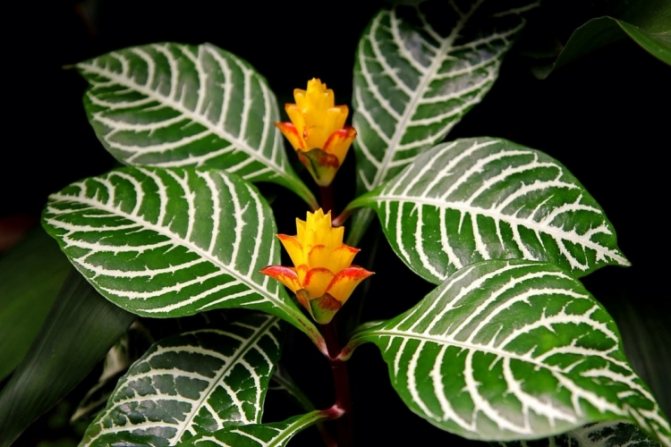

Afelandra breeding methods
Florists use different parts of the plant to breed aphelandra:
- Shoots;
- Seeds;
- Leaves.
The rules for rooting cuttings from twigs and leaves meet the basic requirements for tropical shrubs. It should be mentioned that the leaves are used the most mature and healthy, and the cuttings left after pruning. Rooting is carried out in mini-greenhouses with a sandy-peat substrate. The first new shoots appear after three to four weeks. Young seedlings grow very slowly in the first year.
Seeds are obtained after flowering is complete. Sowing is carried out immediately, without delay, since the seed material quickly loses the percentage of germination. Sown in a mixture of peat and sand. The mini-bed is placed in a warm, lighted room. Experienced growers arrange bottom heating for the early awakening of the sprouts.
Views
There are more than 160 varieties of Afelandra, but only a few of them are grown at home:
- Protruding... Shoots are fleshy, large, reddish in color. The leaves are large, sessile, ovoid-elliptical in shape. They have silvery-white stripes. The flowers are double-lipped, tubular, light yellow in color. The bract is bright orange. Flowering occurs from May to November.
- Tetrahedral... It grows up to 1 meter in height. Leaves are oval, green flower. The inflorescence is spike-shaped, bright scarlet hue.
- Gold (orange)... The stem is juicy and thick, lignifies with development and growth. The leaves are large, oval in shape, with streaks of white. Inflorescences are bright orange. Flowering is very short, no more than one week.
Plant transplant
It is recommended to transplant Afelandru. Young plants in spring, and grown bushes - once every 2-3 years. If you need to transplant a newly purchased specimen or plant germinated seeds, you need to perform several actions common to all cases:
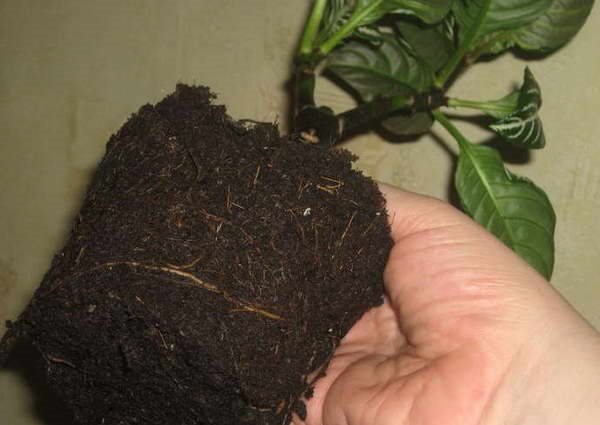

Afelandra transplant is not easy
- Buy or prepare your own substrate consisting of turf, peat and river sand in a ratio of 2: 1: 1.
- Be sure to disinfect it.
- Pour a drainage of expanded clay or small stones on the bottom of the pot on ¼ part of the pot.
- Pour 4 cm thick soil on top for planting adult plants.
- Prepared bushes with peeled stems and washed roots are placed vertically in the ground, its remains are poured in and compacted well.
- For planting seedlings or acquired young plants, the soil in pots is prepared according to the same scheme, only it is laid out all at once.
- After that, plants are planted in it and watered well.
On a note. For transplanting afelandra, you need to choose dishes 5-7 cm higher than the previous one. If parts of the root have been removed, the plant must be watered with Kornevin's solution twice: after planting and after 14 days.
Indoor Afelandra types and features
Afelandra orange grows in Central America. It is a shrub that has been growing for many years. It has a gray-red stem, ovoid foliage up to 25 cm long.
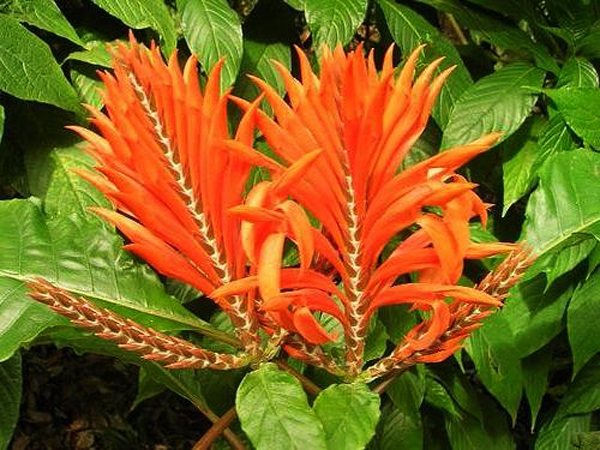

In plants, inflorescences grow in the form of an ear, pointed at the top. This is the name of the culture because of the bright red flowers that bloom for 7 days.
Afelandre scuarrosa or bulging has very decorative foliage. It looks like Afelandra orange, but it is distinguished by lines along the veins on the foliage, and its buds are creamy.
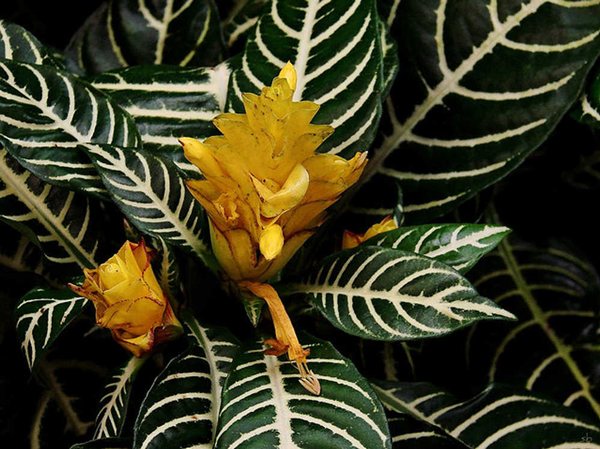

Afelandra crested has bright emerald leaves and large scarlet flowers, they look like ridges on the inflorescences.
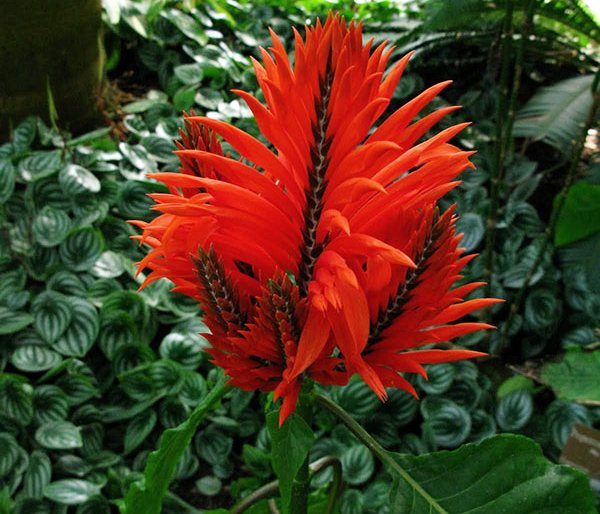

Afelandra coral in height about 3 m, its flowers can be pinkish, scarlet, red, lilac.
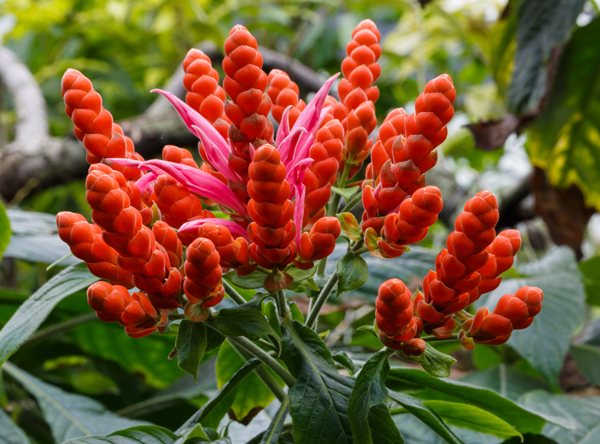

All species bloom in summer.
Possible growing difficulties
Although Afelandra is comparatively resistant to disease and insect pests, sometimes there are some problems with keeping it.
Does not bloom
If the lack of color occurs in bulging aphelandra, this is due to non-observance of the necessary growing conditions. This variety requires a dormant period after flowering is completed - for this, the temperature and the number of waterings are reduced.
You can also find out what to do if the geranium is not blooming.
In other cases, the lack of color is due to a lack of nutrients in the soil. To eliminate this problem, it is necessary to make the appropriate feeding.
Flowering may also be absent due to lack of light.
Diseases
Basically, afelandra is exposed to fungal diseases arising from excessive watering, as well as when using non-disinfected soil for planting, lack of drainage.
Let's consider the main ones:
- Corinespora. This is a fungal disease, which is expressed in the appearance of black-brown spots on the leaves, they gradually become wrinkled and die off. To combat the disease, all diseased leaves are removed and a fungicide is applied.
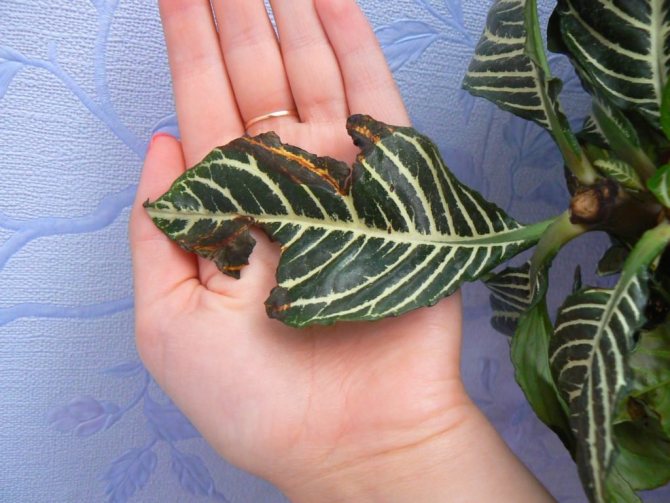

- Leaf spot. It is expressed in the appearance of brownish wet spots on the leaves. The reason is often too high humidity during rooting of cuttings and contaminated soil. To eliminate such a problem, the affected areas of the plant are removed, the soil is changed, and at least 3 times they are treated with fungicides.
- Root rot. The main symptom of the disease is wilting and drying out with sufficient watering. Occurs due to poor drainage and excess moisture at low temperatures. In this case, a transplant with pruning of damaged roots is necessary, as well as their treatment with the chemical "Fitospor".
- Leaf mold. It appears in dark spots on the leaves. For treatment, the leaves damaged by the disease are removed and treated with a fungicide.
- Blackleg. It is recognized by identifying black and thinned areas on the stem at the base, while the leaves wither and die off. The reasons are often lack of ventilation, high temperature, excessive watering, lack of lighting. To solve this problem, they are treated with a fungicide and transplanted into disinfected soil.
- Verticillary wilting. This fungal disease manifests itself in the wilting of the leaves; infection occurs through the soil. Unfortunately, when this disease is detected, the indoor flower must be disposed of so as not to infect neighboring plants.
Afelandra - general view
Like most indoor flowers, aphelandra was originally native to the tropics. From here it is clear that this specimen loves moisture. The shrub is green and can grow up to 2 meters in height.But his domestic relatives are limited only to 1.3 meters in height. There are even smaller varieties that grow up to 0.7 meters.
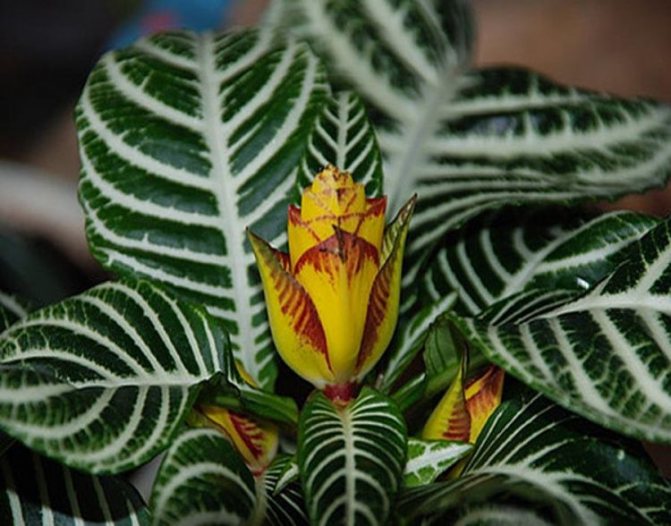

The foliage of Afelandra is shiny and has stripes of a metallic color that is in harmony with the base green. The flower is also good for its bright pyramidal bracts. Their length is about 12 cm. The color is different - orange, yellow, red.
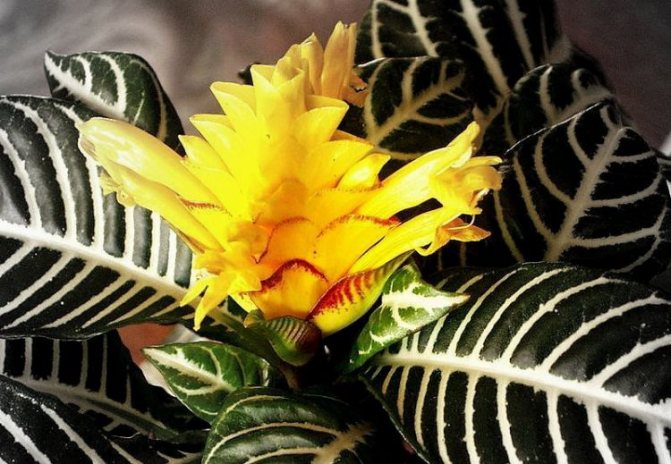

Caution! Poisonous juice oozes in the veins of Afelandra. Therefore, it is imperative to contact the appropriate plant with gloves.
Pruning, transplanting
The branches grow quickly, from which the plant loses its attractiveness. In order for the bush to turn out thick, regularly prune and pinch the branches. Adult plants are pruned only in spring, and you can always pinch young shoots. Shorten old stems by half their length. Cut off the very top from young branches.
Spray frequently after pruning or pinching Afelandru.
How should a flower be transplanted and when? Of course, a transplant will be required immediately after purchase - it is better to use the transshipment method and top up the soil. Repot a young plant, up to 4 years old, every early spring. Then transplant as needed.
Usually the roots become cramped in the pot after two or three years. Choose a pot for this plant that is heavy and tall. This is necessary for good stability when the bush grows. Lay a drainage layer on the bottom. Water abundantly the first time after transplanting Afelandru.
Diseases
Falling leaves
Possible causes of leaf fall can be:
- lack of moisture, leading to drying out of the root system;
- lowering the temperature in the room;
- the presence of a draft in the house;
- exposure to intense sunlight.
Leaves at the edges have acquired a brown tint
This can be served by:
- lack of fresh air supply;
- burn from direct sunlight;
- low humidity;
- leaf mold.
Inflorescences wither
It should be noted that the main reason that the inflorescences wither is the long-term presence of the flower in a draft.
Afelander flower - description
In nature, aphelandras are herbaceous perennials or low-growing shrubs up to two meters high, but in culture they grow no higher than 70 cm.The leaves of aphelandras are large, dark, shiny, sometimes smooth, sometimes prickly, with a wide median and lateral veins, painted white , cream or silver color. Flowers up to 2 cm in diameter with large and hard bracts, often brightly colored, are collected in terminal pineal or spike-shaped inflorescences and have a two-lipped corolla - lilac, red, yellow or orange; the lower lip of the flowers is three-lobed, the upper lip is two-toothed.
The home flower of Afelandra is valued not only for its beautiful and long flowering, but also for its spectacular large leaves.
Homeland of the plant
Protruding Afelandra is an evergreen shrub from the Acanthus family. There are about 170 species of them. Often found in the American tropics and less commonly in the subtropics. Under natural conditions, it reaches two meters in height, at home - no more than 1.3 meters. This thermophilic plant has received a lot of moisture in the wild, so it will not be easy to grow it at home.
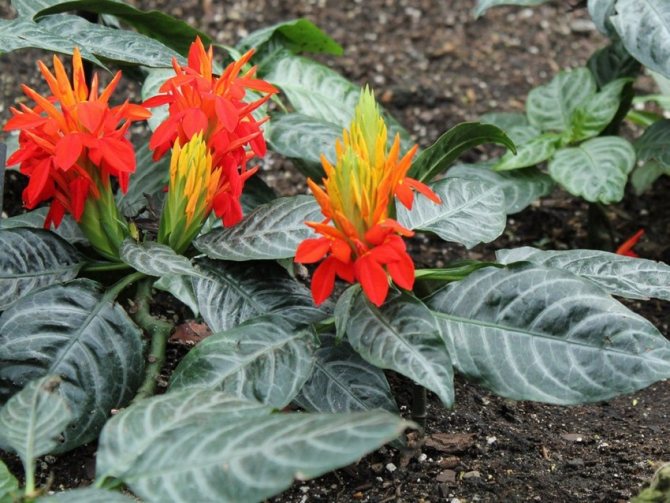

Afelandra - an ornamental tropical plant
How Afelandra can get sick
What pests can damage Afelandra:
- Mealybugs. Small pests not exceeding 5 mm. They have bristles on the body, gather in groups. Remove with soapy water. For processing, use "Rogor", "Aktellik";
- Red spider mite. The smallest pest up to 0.3 mm. Forms a thin cobweb on the underside of the plate. The leaves dry up and fall off. They have a marble look. Of the drugs effective are "Derris", "Malathion";
- Shields. Damage to leaves, petioles, stems. They suck the juice out of the veins. They look like brown plaques. For the fight use "Karbofos", "Decis";
- A sooty mushroom.Appears on leaves after aphids, ticks. It looks like a black film. Disrupts the processes of photosynthesis and respiration. Washed off with a 1% solution of laundry soap;
- Centipedes. Plant in soil. Gnaw at the root system and the base of the stems. Weaken the plant and lead to wilting of the stems. For processing, "Rogor" is used;
- Aphid. Pest infestations cause leaf fall. Insects range from 1 to 5 mm in length. The body is oval or ovoid. To get rid of aphids, the bushes are irrigated with "Profi" or "Feverfew".
Popular: How to plant and grow a predatory Sarracenia at home
Effective folk recipes are used against pests. This is an infusion of garlic, bionastoi on bitter herbs - celandine, dandelion.
Major pests
Shields
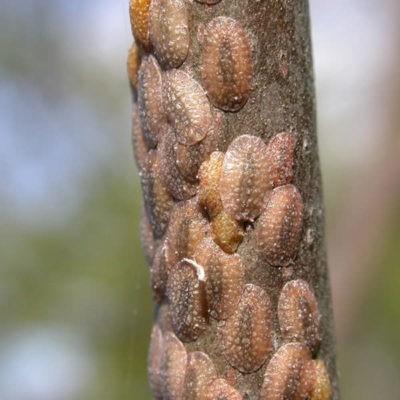

A sticky substance is left on the stem and leaves of the plant, in which a sooty fungus forms, which covers the leaf plates, clogging the pores. As a result, the process of photosynthesis of a flower slows down, its leaves begin to turn yellow and fall off.
Way of struggle: systemic targeted insecticides. In order to avoid the massive development of the parasite, it is necessary to introduce a regime of regular ventilation in a room with indoor plants, it is also recommended to regularly spray, increasing the humidity of the air. These measures are especially effective in summer and during the heating season.
Mealybugs


These small parasites in the process of their vital activity produce sticky mucus of white color, which interferes with the gas exchange of the plant. The flower looks like it has been sprinkled with flour.
Way of struggle: the laying of eggs and the pests themselves are removed with a cotton swab dipped in the following solution: 2 tbsp is taken for 1 liter of soap solution. spoons of vodka. Then the affected plant must be treated with a pesticide.
Spider mites
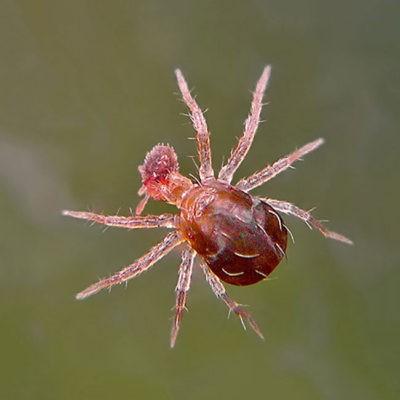

They live on the lower parts of leaf plates, gnaw through their surfaces and suck out cell sap. Leaves become covered with white spots, turn pale, wither and fall off. The plant is all covered with cobwebs.
Way of struggle: the use of acaricidal agents. Since the accelerated mass development and reproduction of spider mites occurs in dry hot air, it is necessary to carefully ventilate the room where the plants grow and spray the plants in the warm season.
Aphids
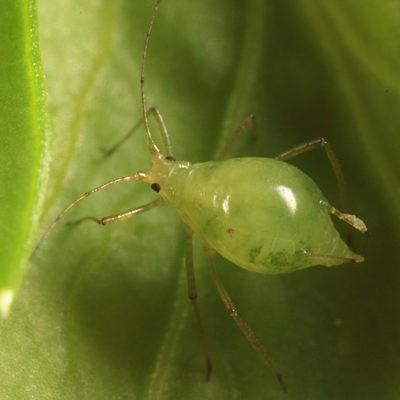

They settle in large groups, reproduce very quickly. These parasites pierce the surfaces of leaves and shoots with their sharp proboscis and suck out the juices of the plant. The flower gradually fades.
Way of struggle: wash off parasites and their eggs from the plant with the help of a shower, while covering the ground with roots from water. Then the flower must be treated with preparations for this type of insect.
General characteristics of the plant and species diversity
Afelandra is a perennial shrub of the Acanthus family. Native to the humid, warm tropical forests of South America. In its natural environment, it can reach two meters, both in height and in volume. But indoor plants of this type grow up to a maximum of one meter. The appearance is quite remarkable: large leaves with a pointed tip have a smooth glossy structure and a contrasting light pattern on a dark green plate.
For this feature, the flower is popularly called "zebra plant". Refers to both decorative deciduous and decorative flowering. It blooms in spike-shaped inflorescences up to twice a year with good care.
General features of the view
The tropical genus has more than 170 representatives, but only a very small part is domesticated. Varieties of the Acanthus family are easy to recognize without reference to the variety, since within the species they have common features:
- erect stem, which in some representatives may differ in reddish color or becomes woody with age;
- corrugated striped fleshy sheet, wide, lanceolate;
- small flowers and bright spike-shaped bracts of orange, yellow or red shades;
- not all varieties can achieve fruiting, but all varieties die after it, therefore, when the flowers begin to wilt, they are immediately cut off.
Protruding aphelandra
It is the most common variety in indoor cultivation due to its tolerance to cold temperatures compared to other species. The protruding aphelandra is originally from Mexico. The size of a flower can reach one and a half meters in its natural environment, but no more than 50-70 cm grow in an apartment.
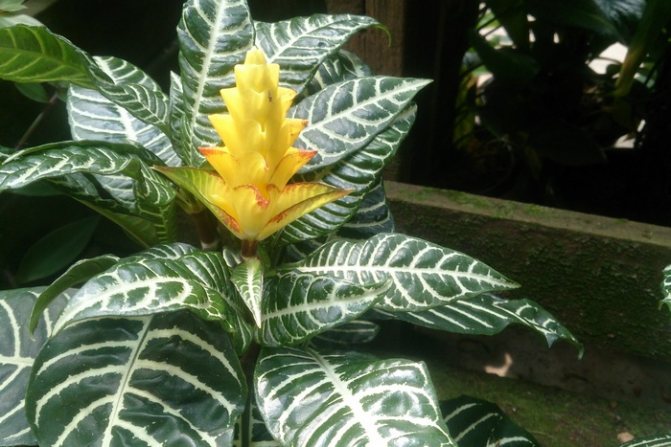

Protruding aphelandra
The stem is glabrous, strong, has a reddish tint. The leaf blade is wide, dark green in color, with a glossy structure and a white outline. The shade of the reverse side of the sheet is lighter in color, so the pattern on it is less noticeable. Flowering period from June to November: blooms with a two-lipped yellow tubular flower. When the bud fades, a small fruit appears (up to 0.5 cm), which has the shape of a box with seeds inside.
This species includes the following varieties:
- Dania - has bright white veins on the leaf and variegated inflorescences.
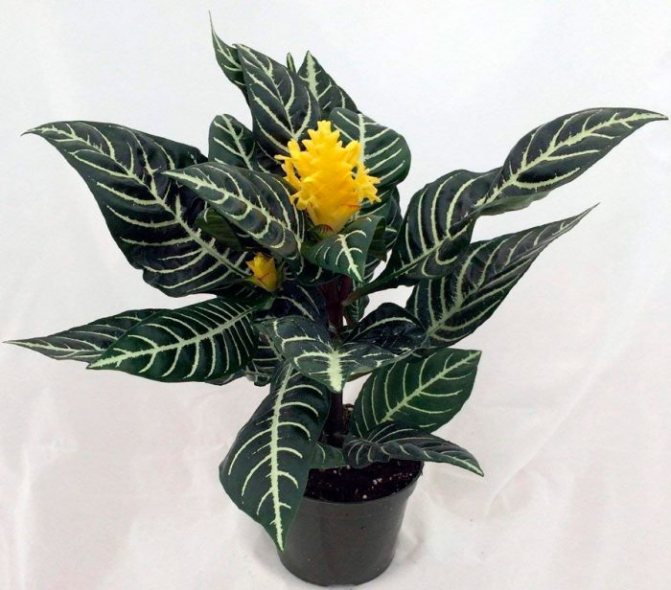

Dania - Louisae has a reddish stem and wide, sinewy leaves.
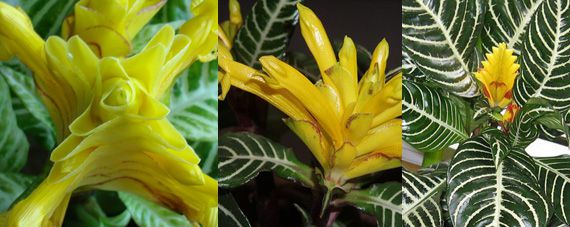

Louisae - Leopoldi is distinguished from other varieties by its orange flower.
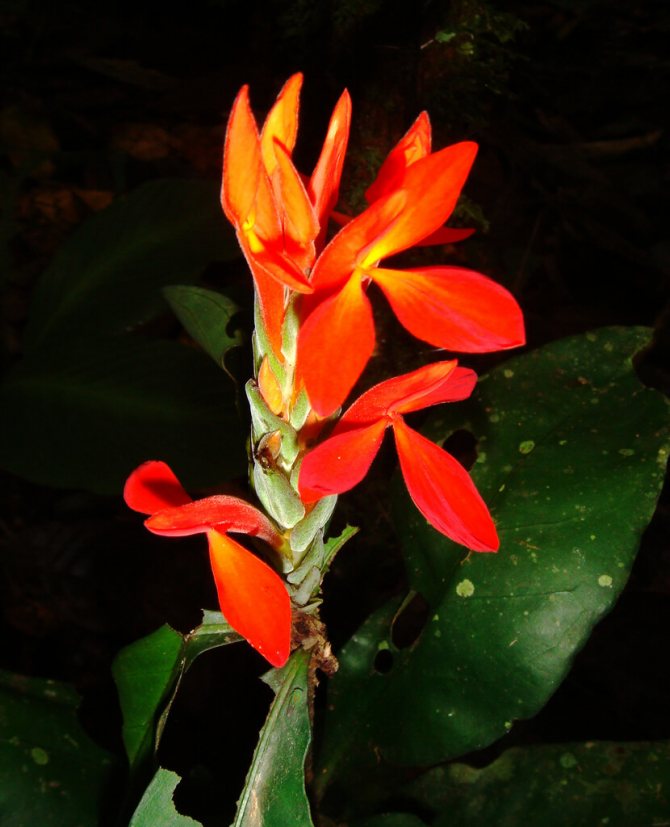

Leopoldi
Other varieties
Less popular, but no less attractive are the following varieties:
- Squarrosa has large (up to 30 cm) leaves, on which silvery-green veins stand out. The buds are bright scarlet or orange. However, it does not bloom very often. Flowering directly depends on long-term lighting.
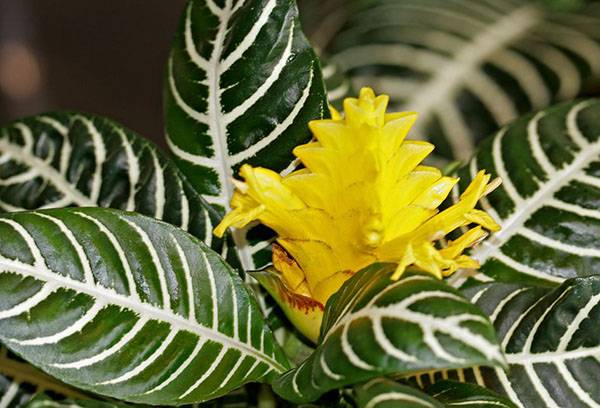

Squarrosa - Gold (orange) - a bush with woody reddish shoots. The leaf has an oval shape and a smooth surface of green with a bronze tint, about 25 cm long. Flowers grow up to 15 cm long and are orange in color, but the bud does not last long, no longer than 14 days.
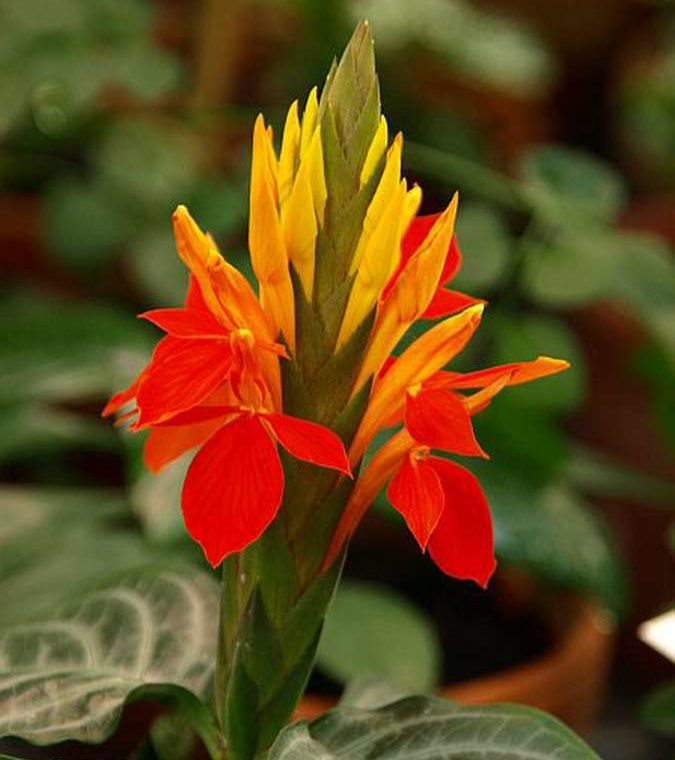

Afelandra the golden - Retzlya is a kind of Aurantiaca cultivar. The leaf is large, silvery white. It blooms for no more than a week with orange-red inflorescences. Feature in easy fruiting, which can be used for collecting seeds and further propagation.
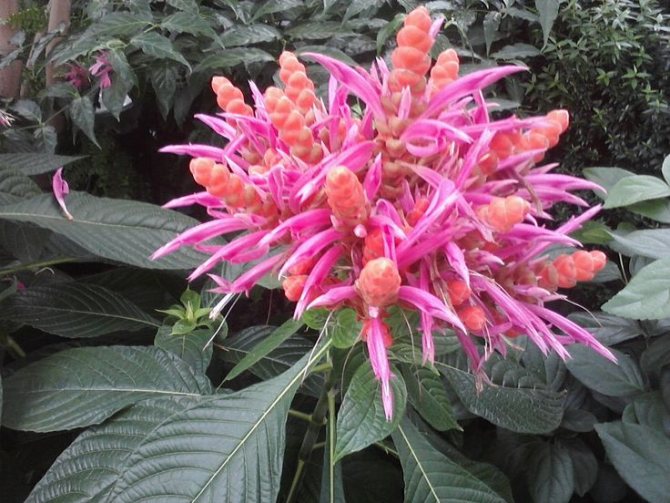

Retzla
Features of planting and transplanting
Advice! The culture likes soil with an acidity of 5.5 to 6.5, that is, neutral or slightly acidic.
If the soil has acidic characteristics, then the foliage turns yellow, the plants do not bloom. In soil with alkaline properties, the flower stops growing and dies after a while.
Pick a pot that is tall and heavy so it doesn't wobble. A ceramic container not covered with glaze is ideal. Each time, take a pot 5-7 cm larger than the previous one. There should be drainage holes in the bottom.
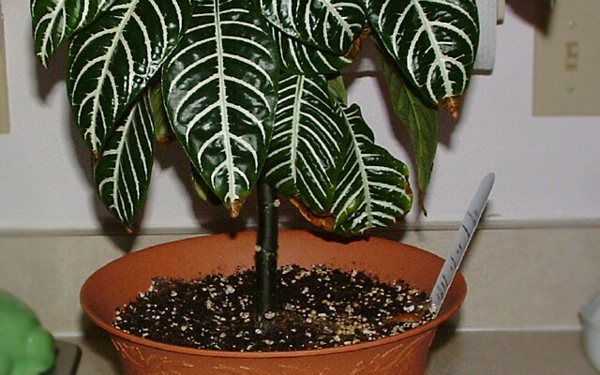

To make a substrate, mix equal parts of leafy soil, brownish peat, washed river sand. Pour crushed coal into this soil. If the soil is too heavy, dense, then add vermiculite. Add sphagnum moss as well.
Before planting, the soil must be disinfected: spill it with boiling water or place it for 5 minutes. into the oven.
When to transplant
A young culture is transplanted annually, each time picking up a pot with a larger capacity. This stimulates flowering.
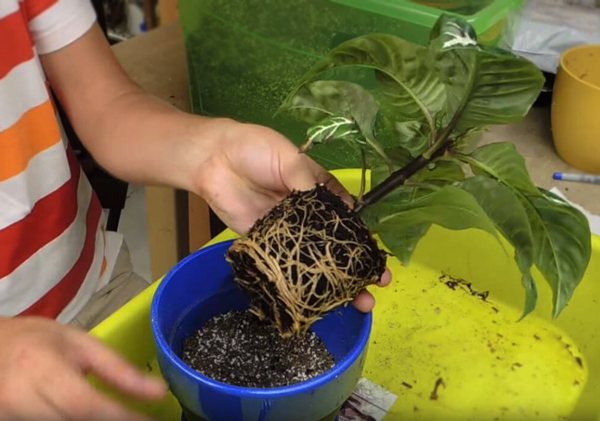

When the plant is 4 years old, it should be replanted every 2-3 years. The best thing to do is early spring.
Step by step process
Sequence of steps when transplanting:
- Water the plant thoroughly, carefully remove it from the container. Examine the rhizome carefully.
- If you find rot or dried roots, then cut them with a knife to healthy places.
- If there is no rot, then do not damage the rhizome, do not destroy a lump with earth.
- Pour expanded clay or broken brick into the container ¼. Then add 3-4 cm of soil.
- Place the crop on the ground, spread the roots. Sprinkle with soil, tamp a little. Top with decorative stones mulch. And then pour abundantly. If you cut the roots, then after transplanting and after 2 weeks, spill the plant with Epin's solution.
Pruning
Even "in captivity" Afelandra grows rather quickly, therefore it needs annual formative pruning. It is carried out at the end of winter, before the beginning of the intensive growth phase. In a young flower, it is enough to pinch the upper shoots by 2-3 buds in order to achieve greater splendor and "bushiness".
Adult plants lose their decorative appearance, shedding the lower leaves, the trunk is ugly stretched. If pinching the upper shoots does not help, cut off everything, leaving "hemp" about 30 cm long. Then put a plastic bag on the pot, fix it hermetically and leave the aphelandra in this form for 3-4 weeks, spraying 2-3 times daily.
When this procedure did not give the desired result, the only way out is to cut off the apical stalk and root it again.
Common problems when growing Afelandra - table
| Description of the problem | Most likely causes |
| Withering and falling leaves | Insufficient watering. Even a short-term moisture deficit causes Afelandra to shed its leaves. It can also be due to low temperatures and / or the presence of cold drafts in the room. Most often, it is no longer possible to save the plant. Grow new from the cuttings. |
| The tips of the leaves turn brown, curl and dry out. | The room humidity is not high enough. Spray the plant more often, put wet moss, peat, expanded clay in the pan. Move the pot away from working radiators. |
| Separate areas of the leaf plate change color to brownish. | This is either a sunburn from direct sunlight on the leaves, or a consequence of insufficiently clean air. Ventilate the room more often. |
| The leaves become smaller, deformed, lose brightness, wither. | The reason is insufficient, excess or incorrect fertilization. Examine the plant to determine which micro- and macronutrients are missing. Do not exceed the manufacturer's recommended concentration when preparing the solution. |
| Rot at the base of the trunk and leaves | Excessive watering. Increase the intervals between them and reduce the watering rate. Be sure to pour excess water out of the sump. If the plant is badly damaged, it is worth removing it from the pot and inspecting the roots for rot. In case of local damage, leaves with traces of rot are cut off, special attention is paid to the roots at the next transplant. |
| The stem becomes thinner and longer, the inflorescence does not form or turns out to be deformed. | Afelandre lacks light. Move it to where there is more sun, or use fluorescent lamps for additional lighting. |
Diseases and pests
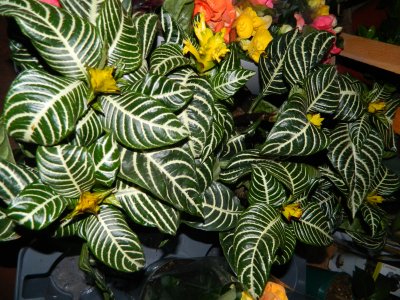

Afelandra is a moody plant, and if not properly cared for, it dries up, becomes stained, or sheds leaves.
Methods of treatment and control
- the tips of the leaves dry out - dry air. It is necessary to spray more often, put it next to a source of moisture, remove it from heating batteries and electrical appliances;
- leaves become wrinkled and curl - the plant stands in direct sunlight in dry air. You need to shade it, make the air humid;
- rot on the stem at the point of contact with the soil - occurs in winter in conditions of low light and low temperature. Move closer to the light source in a warmer room.
In addition, the plant can become infected with pests - aphids, spider mites, scale insects. To remove them, you need to rinse the leaves with a soft soapy sponge, and then treat with special insecticides.
- what to do if aphelandra leaves fall?
Leaf shedding is a standard response to improper care.
This happens in the following cases:
- sunburn or dry air;
- drying out of the soil (insufficient watering);
- being in a draft;
- low air temperature, irrigation with cold water.
It is necessary to determine the reason due to which the fall occurred and eliminate it.
Afelandra is a beautiful tropical plant. But it is demanding on environmental conditions, and therefore it cannot be advised to novice growers.If a flower appears in the house, you need to surround it with attention and care.
Afelandra care
Afelandra rightfully belongs to the most beautiful decorative flowering plants. The flowering period begins in this plant at a time when most of all flowers are preparing for the dormant period.
The name of the plant in translation means "simple man". Despite the decorativeness of the inflorescences, the plant looks no less impressive without them, since the leaves of the aphelandra are very attractive. However, caring for this exotic handsome man is quite difficult, because it is difficult and not always possible to recreate a tropical climate in an apartment.
What conditions does Afelandre need for growth and lush bloom? Let's figure it out.
Homeland and appearance of Afelandra
Afelandra is native to the rainforests of South, Central and North America. All representatives of the acanthus family, to which Afelandra belongs, are evergreen shrubs and dwarf shrubs. In particular, Afelandra is a shrub up to half a meter high with beautiful corrugated leaves that are located opposite on the stems. The color of the leaf plates is variegated due to the presence of silvery veins on a dark green background.
Afelandra flowers are collected in tetrahedral inflorescences from 12 to 15 cm long. The palette of inflorescences is yellow-orange. The flowering period lasts from two to three months. Then it is necessary to cut off dry inflorescences so that fruits with seeds do not form.
Once every three years, the plant needs to be rejuvenated by rooting cuttings. Such a need arises due to the fact that as the aphelandra grows, it sheds its leaves and loses its decorative effect.
In indoor floriculture, the following varieties are most often found:
- Afelandra protruding;
- Afelandra golden;
- Afelandra four-sided.
As a rule, Afelandra is used for decorative purposes to decorate the winter garden and exhibition spaces. The flower looks attractive both independently and in a group with other indoor plants.
As noted above, Afelandra needs a tropical climate, which, alas, is unusual for city apartments.
Important conditions for the successful cultivation of a flower are: high air temperature, sufficient moisture and a complete absence of drafts.
Watering mode
Comfortable watering frequency:
- In the summer - the earthen lump must constantly remain moist;
- In autumn and winter, the earthen lump should dry out a little between waterings.
Overdrying or waterlogging of an earthen coma leads to rapid wilting and death of leaves.
Lighting requirements
Afelandra feels best on brightly lit windowsills or in greenhouses. However, direct sunlight should be avoided. If it is not possible to put the flower in another place, you should shade the flowerpot. The optimal solution for the plant is the windows of the east and west orientation. It is necessary to shade on the southern windows in the summer from 11-00 to 17-00. In hot weather, the flower feels good in the fresh air, the main thing is to protect the bush from drafts.
Temperature regime
Comfortable temperature for the plant:
- Daytime - not higher than +27 degrees;
- Night - not lower than +18 degrees.
The vast majority of Afelandra varieties are able to withstand temperatures of +13 degrees for a week.
The room needs to be regularly ventilated, but drafts should be avoided, while the temperature should not fall below +18 degrees, so that the plant does not experience sudden temperature changes. For a protruding aphelandra for several months, the temperature should be maintained no higher than +10 degrees. This stimulates flowering and bud formation.
Air humidity
The humidity of city apartments is not sufficient for growing Afelandra, therefore it should be used throughout the year. artificial methods of moisturizing:
- Spraying.It is held only in summer in sunny weather. Otherwise, high humidity can lead to the death of the plant.
- Household humidifiers. Used in winter.
- Containers with water. They can also be used in winter. They provide a long lasting effect.
Fertilizing and feeding
Afelandra needs a lot of mineral and organic fertilizers. They should be applied once every few times during watering. Observing the plant, you can adjust the amount and composition of the fertilizers applied.
If the leaves acquire a yellowish tint, become small, this indicates a lack of nitrogen.
In the absence of buds, the amount of nitrogen should be reduced.
If the inflorescences are small, lose brightness, this may indicate an insufficient amount of phosphorus.
With a lack of potassium, the leaves may fall off, yellow or brown spots appear on them.
The soil
The acidity of the soil should vary from 5.5 to 6.5 pH. In the case of Afelandra, it is the correct choice of the earthen mixture that largely guarantees the success of flower cultivation.
The soil should be loose and fibrous.
If the soil is too acidic, the foliage will turn yellow, the inflorescences will become small. With an alkaline reaction of the soil, the plant stops growing.
For Afelandra, you can choose one of the following recipes for the earthen mixture:
- Leafy land - 4 parts, one part each sand and peat;
- Brown peat - 3 parts, one part each of moss, sand and leafy earth, 10% of crushed coal and a few tablespoons of superphosphate;
- Leafy earth - 4 parts, humus - 2 parts, one part each of moss and vermiculite, 10% coal and a few tablespoons of bone meal;
- Leafy land - 8 parts, sod land - 5 parts, two parts each of peat, charcoal and coniferous land, one part vermiculite;
- Sod land - 3 parts, one part each of coniferous land, peat, vermiculite, moss and humus.
Regardless of which earthen mixture is chosen, it must be sterilized before use.
Types of Afelandra with photos and names
Under natural conditions, about 170 plant varieties are found, but culturally only two.
Aphelandra protruding or squarrosa Aphelandra squarrosa
Aphelandra protruding Aphelandra squarrosa photo
It grows in indoor conditions up to 130 cm. The plant stretches rather quickly, losing its decorative effect, so growers prefer hybrids: Denmark, Brockfield, Louise.
The meaning of a flower in the house
Afelandra in the house primarily performs a decorative function - after all, this plant is very beautiful, especially during the flowering period. An exotic flower will decorate any room and composition of indoor plants.
According to the zodiac sign, Alefandra is suitable for Leo. The representatives of this sign are perfectly matched with bright flowers of yellow, red and orange colors.
Feng Shui has a positive attitude towards flowers growing upwards. They are believed to activate positive energy.
Did you know? In the language of flowers, red is the color of life and love, but it can also express anger and desire for revenge. The yellow color speaks of disgust and hatred, and the golden tone symbolizes the sun and joy. In the East, yellow is treated differently, considering it the color of wisdom.
Afelandra is a fast growing plant with beautiful large leaves and luxurious flowering. So that the decorative appearance of this flower does not suffer, it must be well looked after, since it is picky about growing conditions, and regularly updated.
How Afelandra reproduces
At home, flower reproduction is possible by seeds and cuttings.
Germinating seeds
Sow well-ripened seeds in a container with a mixture of leafy soil and sand. The earth must be well moistened with warm water with a weak solution of manganese. Germination is carried out in a greenhouse or in a house at a temperature of +25 degrees. The soil must be regularly ventilated. When the sprouts are older, transplant them into flower pots.
Rooting cuttings
Reproduction by cuttings is the most affordable. In the spring, choose an annual shoot on the plant. Cut it off so that there are 2-3 leaves on it, and treat it with a root formation stimulant. Plant in a pot with peat-sandy soil or in a greenhouse. Cover with glass or cellophane to create a greenhouse effect. Ventilate daily for 10 minutes. Rooting occurs at 22 degrees of heat for 1.5-2 months. Then plant the cuttings that gave the roots in flower containers.
How to propagate Afelandra?
Afelandra propagation is carried out in three ways:
- Seed - ready-made seeds are planted in the ground, watered before and after germination, and when the seedling age is reached, the bushes dive;
- Cherenkovy - one-year-old shoots are cut off from the mother bush, then the latter are soaked in Kornevin's solution for a day, after which they take root in a nutritious substrate for a month;
- Deciduous - not much different from cuttings, with the exception of the use of leaves as planting material.
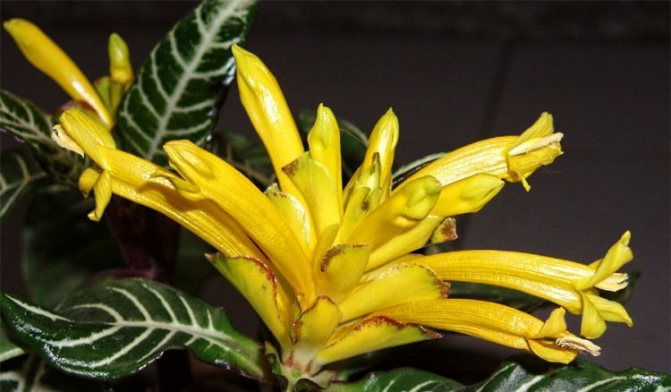

The water for soaking Afelandra sprouts must be perfectly clean. Otherwise, young shoots will become infected.
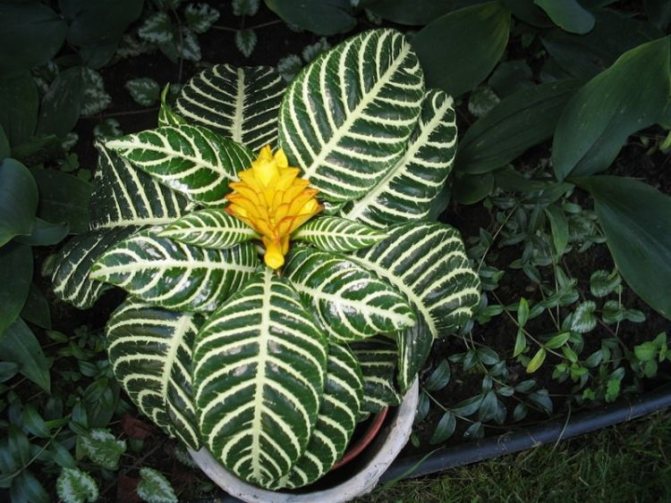

Necessary care
Caring for afelandra requires a significant investment of time and effort from the grower. But most of them think the result is worth it.
Watering
Both insufficient and too abundant watering are destructive for Afelandra. Your task is to find some kind of middle ground, not allowing the soil to dry out, but not turning the pot into a swamp.
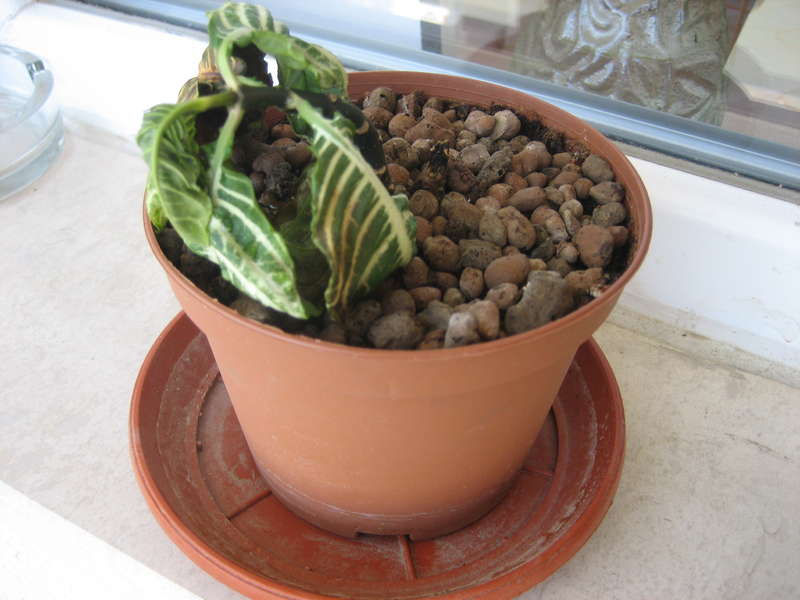

Balancing is important when watering Afelandra
In the phase of intensive growth (from early spring to late summer), Afelandra needs water. One watering every 3-4 days is enough. Pour water directly under the root, trying to avoid getting it on the leaves if possible. After a quarter of an hour, drain the excess liquid from the pan.
For irrigation, use water at room temperature, settled for at least a day. If possible, water with rain or melt water. Pre-soften hard tap water with citric acid. For a 10 liter bucket, 3-5 granules are enough. Be sure to wait for a precipitate in the form of whitish or grayish flakes.
With the beginning of autumn, watering is gradually reduced, bringing the plant to a dormant period.
Top dressing
In addition to abundant watering, Afelandra needs additional feeding in the process of growth and flowering. It is applied regularly, every 15-18 days, alternating liquid complex fertilizers for decorative flowering plants and self-prepared organic fertilizers.
Home organic - infusion of fresh cow dung, bird droppings or nettle. These are natural sources of nitrogen. With its lack, aphelandra leaves fade, shrink, wither, the inflorescence is formed slowly, deformed or not formed at all, the flowering period is greatly reduced.
It is best to prepare funds in the country. Even through a closed lid, a specific "aroma" is felt. About a third of the selected container is filled with raw materials, top up with warm water to the brim and tightly closed. After 4-7 days, after the appearance of a characteristic odor, the fertilizer is intensively stirred, take 0.5 l per 10 l of pure water and water the plants with a solution.
The products purchased in the store are diluted, strictly following the manufacturer's instructions on the packaging or in the instructions. Choose a fertilizer based on the condition of the flower. Phosphorus deficiency is indicated by the absence of flowering or too small flowers of a dull color. A lack of potassium can be recognized by a decrease in the number of new leaves and the saturation of their color, their small size, holes formed in the place of dead areas of the leaf plate.
Bloom
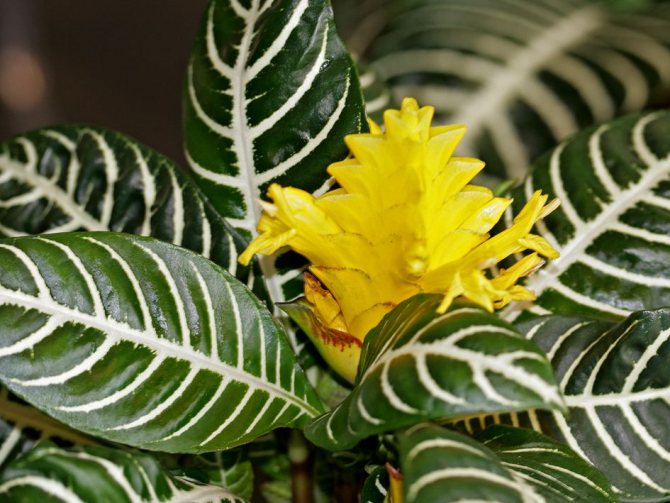

Afelandra needs attention during flowering
The flowering time directly depends on the Afelandra variety. Most often, it begins in late spring and lasts most of the summer, or it occurs at the end of July and lasts until mid-autumn.
If you do not set yourself the goal of growing and collecting seeds, immediately after the plant has faded, cut the inflorescence as close to the base as possible. The formation of seeds takes away a lot of strength and nutrients from Afelandra, which she will still need during her dormant period.
Dormant period
The dormant period for Afelandra begins in November and lasts 3.5–4 months. At this time, the plant is transferred to a bright, cool room with a temperature of about +20 ºС. Humidity can also be slightly lowered (up to 75–80%). At the beginning of spring, Afelandra is returned to its original place.
Top dressing is stopped altogether, watering is reduced to 1 time per week. If the potted soil dries out away from the edges, water the plant a little off-schedule.
Bloom
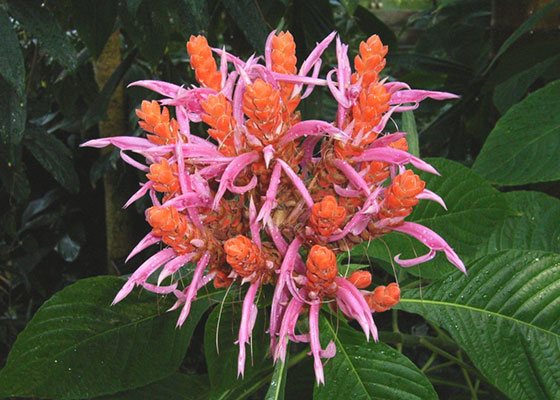

Hybrid varieties bloom for a long time, follow this process carefully. As soon as the first signs of wilting appear on the inflorescence, cut them off immediately to prevent the formation of fruits.
If this is not done, then the wilting process will quickly spread to all inflorescences. It is necessary to prevent the appearance of fruits for the sake of preserving the life of the plant. The fact is that after fruiting, the flower dies.
In order for Afelandra to bloom violently, provide it with the proper conditions during the winter holidays. After the end of flowering, remove the pot in a cool room until spring. During this time, water and spray the Afelandra occasionally.
Conditions for growing at home
For this capricious indoor flower, optimal conditions must be created, otherwise it will shed its beautiful leaves.
Lighting
If this plant is illuminated for less than 8 hours, it needs additional lighting with a phytolamp. With a lack of light, it stretches out, looks less decorative and stops blooming. Afelandra prefers diffused light, and direct rays of the sun can burn her, so the plant is shaded from the sun.
Temperature
This flower from the tropics loves warmth and requires a temperature regime within + 18 ... + 25 ° С. The room conditions are quite suitable for him, but you need to make sure that there are no drafts when airing the room. In winter, it is recommended to lower the temperature to + 16 ° C. Lowering the temperature below + 13 ° C negatively affects the plant.
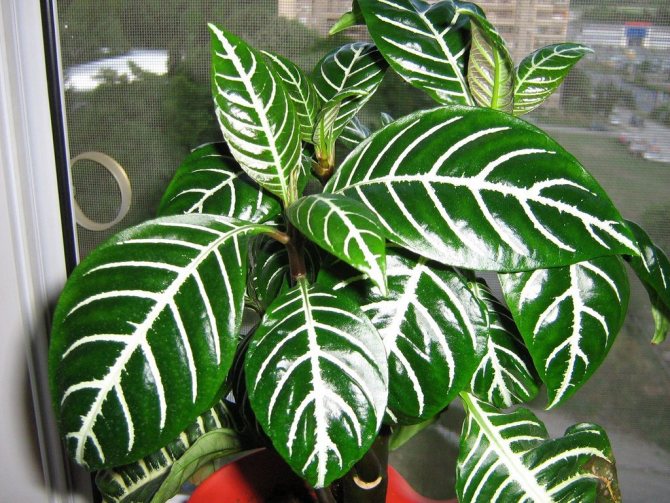

Air humidity
Afelandra loves humid air; it is recommended to spray it daily from a fine spray bottle. This is especially true during the heating season, when the batteries dry the air very much. Boiled water is used for spraying. It is useful to do airing, but so that the plant does not suffer from cold and draft.
With insufficient air humidity, the flower becomes sensitive to many diseases and sheds its leaves. The first to signal a lack of moisture will be that the tips of the leaves of the aphelandra will begin to dry.
You may also be interested in what and how to properly water geraniums for abundant flowering at home.
In order not to spray the plant all the time when the air is dry, it is recommended to put a pallet with decorative pebbles under it, which is moistened with water. This hydration lasts for a long time.
Useful properties of afelandra
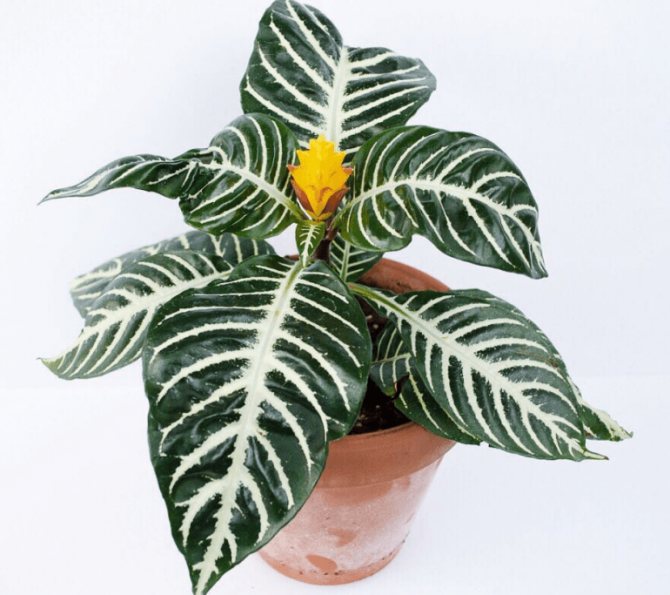

You should know that the tropical representative is not only beautiful, but also very useful for human health:
- focusing on the variegated color of the foliage, you can get rid of depression, the effects of stress, headaches, plant relaxation is one of the best methods to improve performance;
- the healing composition of the leaves is an excellent assistant for burns, frostbite and skin abscesses.
Afelandra photo
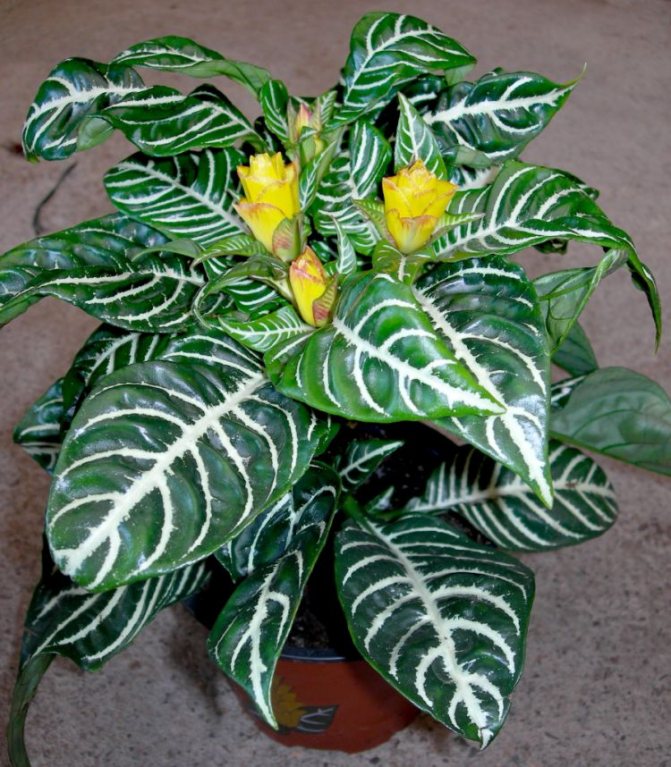



Washingtonia: species with photos and names, a brief description of the cultivation, useful properties. Detailed instructions on how to care at home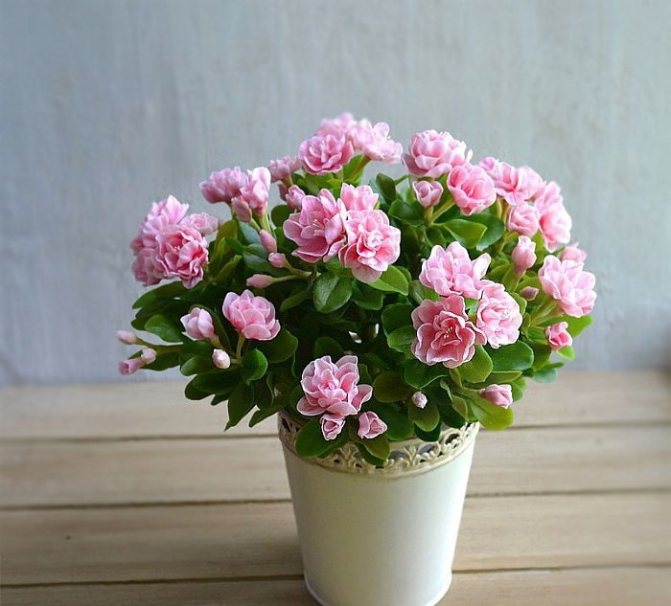

Azalea: description, types and varieties, methods of reproduction, planting. Rules of care, watering, plant formation, feeding. Diseases and pests. 70 photos of blooming azaleas
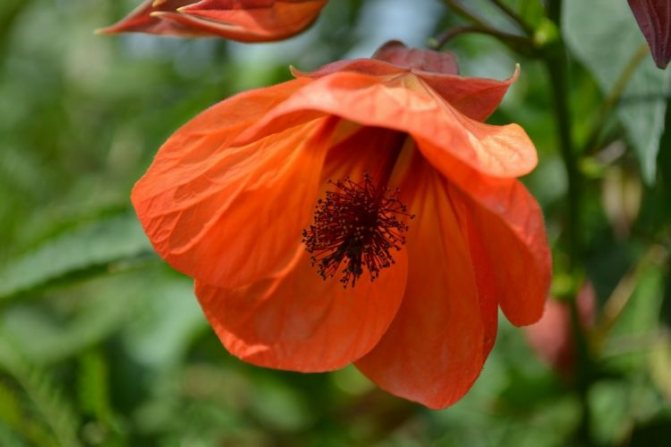

Abutilon - types, growing rules and home care.Diseases and pests, planting and reproduction of "indoor maple"
Read: Anthurium - options for application in design, the nuances of care, cultivation and transplantation (105 photos and videos)
Did you like the article? Please share with your friends 

0
Write a comment
New design
Provence curtains - design ideas and an overview of the ideal combinations of curtains in a rustic style (110 photos and videos)
Minimalism in the apartment - interior ideas and design options. Tips for applying different styles (100 photos)
Kitchen-living room 20 sq. m. - design ideas, interior design options and an overview of the most stylish combinations (110 photos)
Living room decoration - tips for choosing colors and materials. An overview of the most beautiful living room design ideas (90 photos + video)


